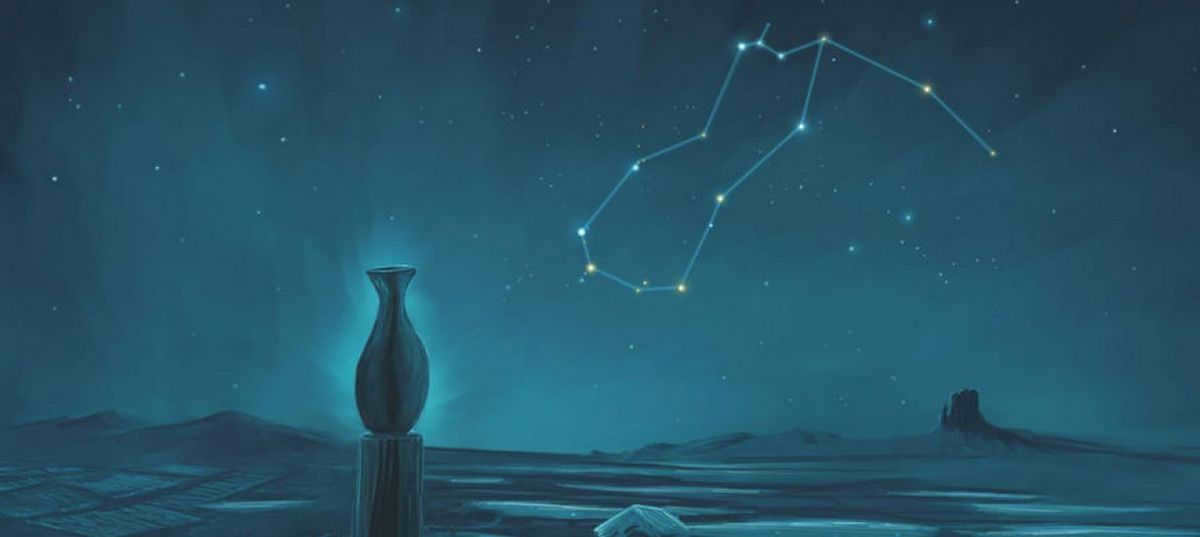
Aquarius constellation is one of the largest constellations in both the zodiacal circle and the entire sky. It covers an area of 980 square degrees, ranking tenth among all other constellations. Because of its size, Aquarius has numerous neighboring constellations, including Capricorn and Pisces.

Legends and Stories
The constellation Aquarius represents a water bearer, as the name suggests. In ancient times, various cultures had their own interpretations of the origins of this constellation. The Sumerians, for instance, believed it was associated with one of their three major gods, Ea, who governed the subterranean waters.

The constellations of Aquarius and its shining stars
One of the most prominent stars in Aquarius is Beta – Sadalsuud, which holds an Arabic meaning of “the luckiest among the fortunate” or “the most fortunate of all”. This name was given due to the Sun setting in Aquarius during the arrival of spring, marking the end of winter and the start of the rainy season. Beta – Sadalsuud is a rare yellow supergiant star, characterized by its relatively low temperature and moderate luminosity. Interestingly, its luminosity is even lower than that of Alpha Aquarius, but it appears brighter due to its closer proximity to Earth.
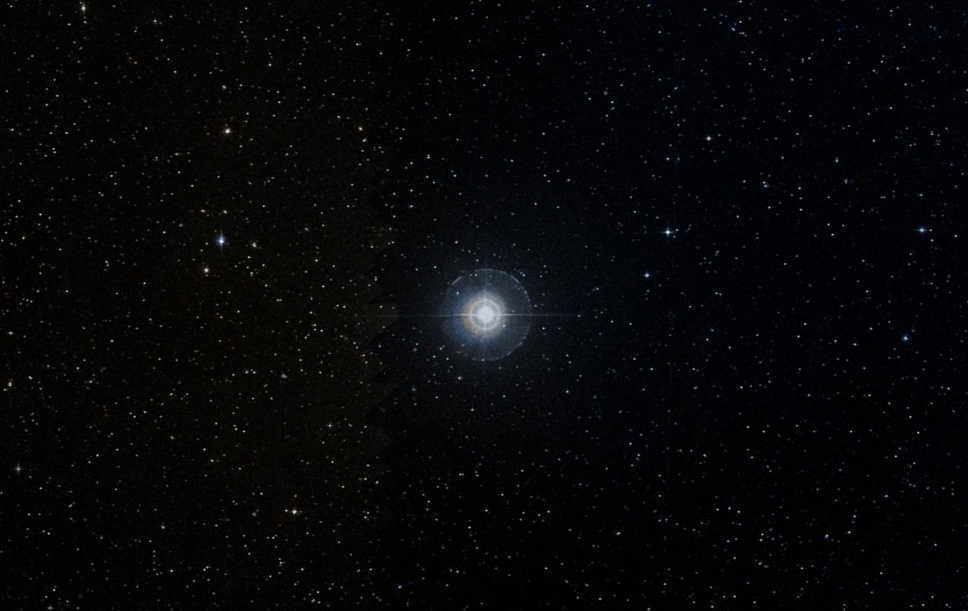
The alpha star in the constellation Aquarius is called Sadalmelik, which translates to “happiness of the king” or “happiness of the kingdom”. This star is a rare yellow supergiant, similar to Sadalsuud. Interestingly, the Alpha and Beta stars of Aquarius are almost indistinguishable from each other. What makes them unique is that stars of their size are typically either hotter and bluer or smaller and redder in color.
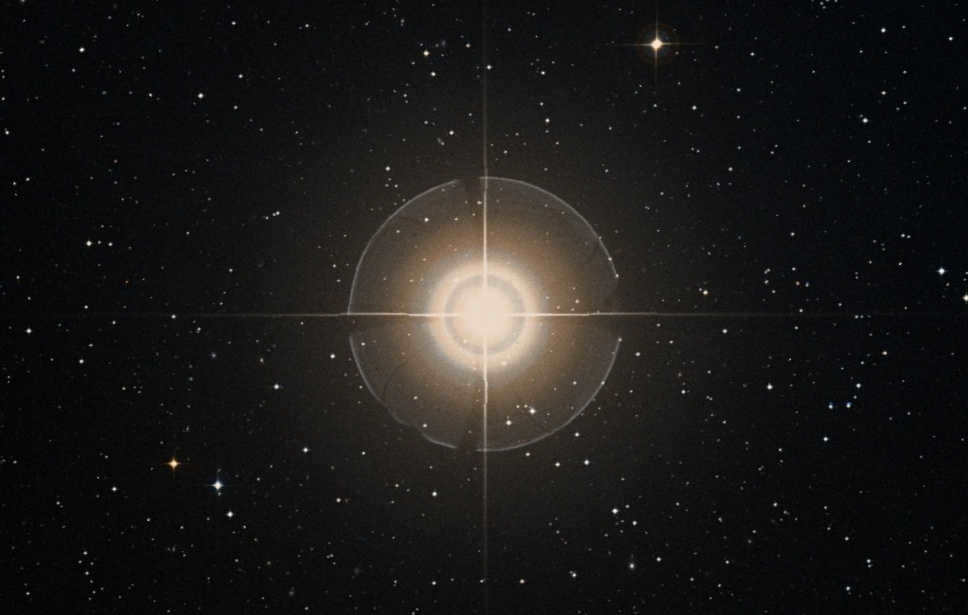

Delta is the third most luminous star in the constellation of Aquarius. It is classified as a blue subgiant and goes by the name Scutus, which translates to “foot.” Another name for this star is Sheat, which means “desire.” There have been suggestions that Delta might actually be a binary system.
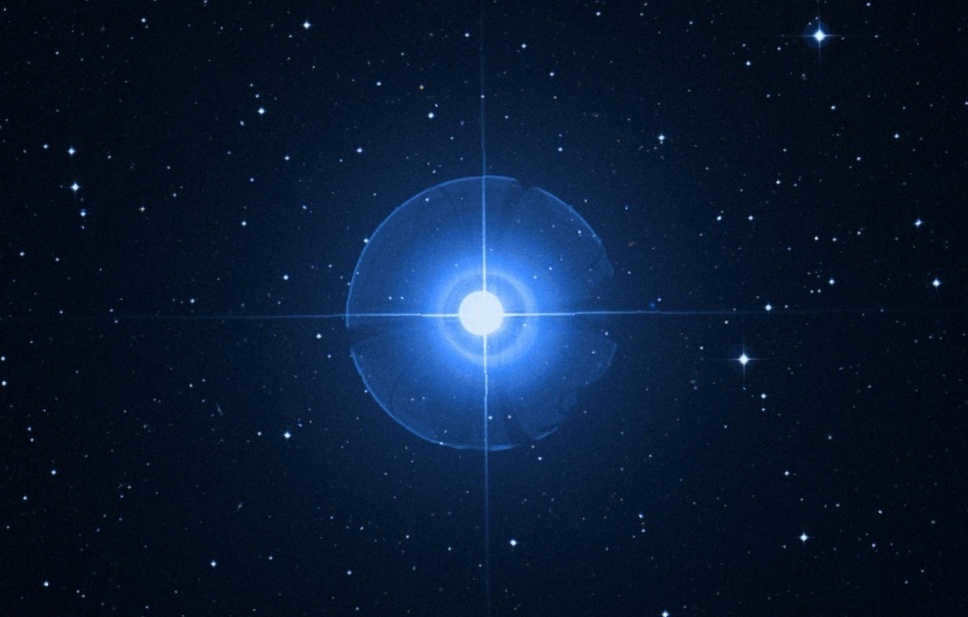
Zeta Aquarius consists of two yellow-white stars and one orange star, making it a triple star system. Scientists estimate that the system has been around for approximately 3 billion years.
Lambda, also known as 73 Aquarius, is a red giant. It is a pulsating slow irregular variable star that has not been given an individual name.
Epsilon, known as Albali, is a white star. Its name translates to “swallowing”.
Gamma Aquarius is a binary system named Sadahbia, which means “happiness in the home”. It consists of a white star and its companion.
This particular star is a blue-white subgiant, three times larger and more massive than our Sun.
Theta Aquarius is an orange giant named Ankh. Its name translates to “pelvic bone”.
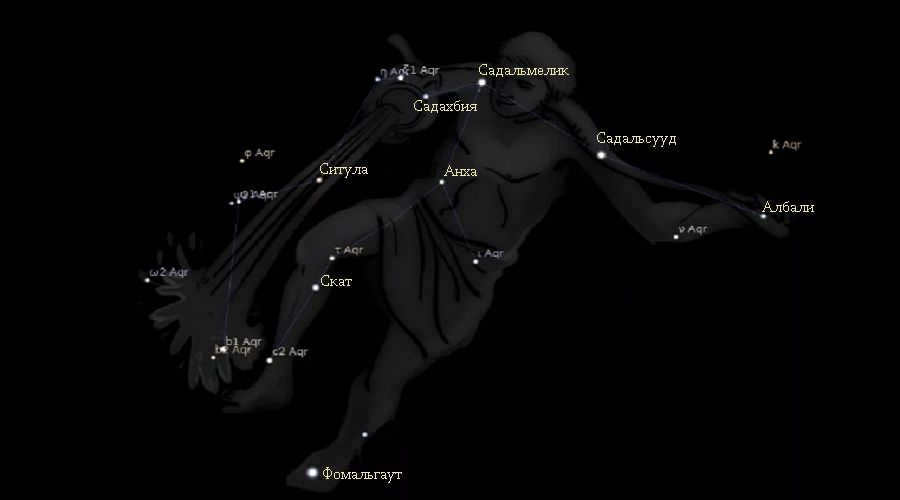
The red giant with a companion represents Phi in the Aquarius constellation. This star is incredibly old, being nearly 11 billion years old.
Iota, another star in Aquarius, is a blue-white subgiant that is similar in size to Eta and its companion.
Nu Aquarius is a star whose exact color cannot be determined. It is either yellow or orange and is a giant with very high luminosity.
Xi and Myu in the constellation are both represented by double systems consisting of a white giant and its companion.
Omicron, on the other hand, is an extremely hot star. It is a blue-white subgiant with a luminosity 340 times that of the Sun.
Within the constellation Aquarius, there exist three Messier objects, out of which two are globular clusters. M2, being one of the most expansive globular clusters in the entirety of the celestial sphere, is home to approximately 150,000 distinct stars. M72, on the other hand, boasts an abundance of variable stars.

M73 is a group of four stars that form a unique pattern in the night sky. In the past, astronomers mistakenly believed that M73 was a star cluster, but further observations revealed that these stars are actually moving in different directions and are significantly distant from each other.
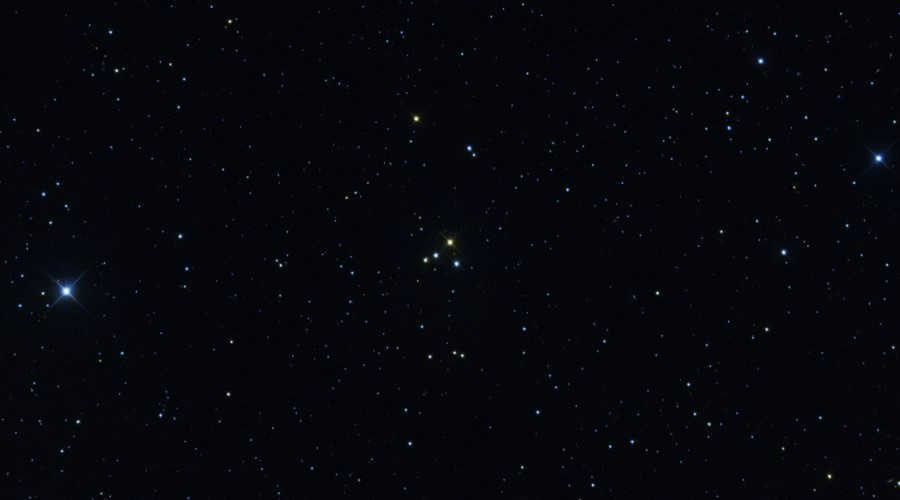
Aquarius constellation also houses the dwarf galaxy, which is a member of the Local Group, consisting of the Milky Way as well. Furthermore, within this constellation, one can observe the presence of the spiral galaxy NGC 7727, formed due to the amalgamation of two other systems, along with a few elliptical galaxies.
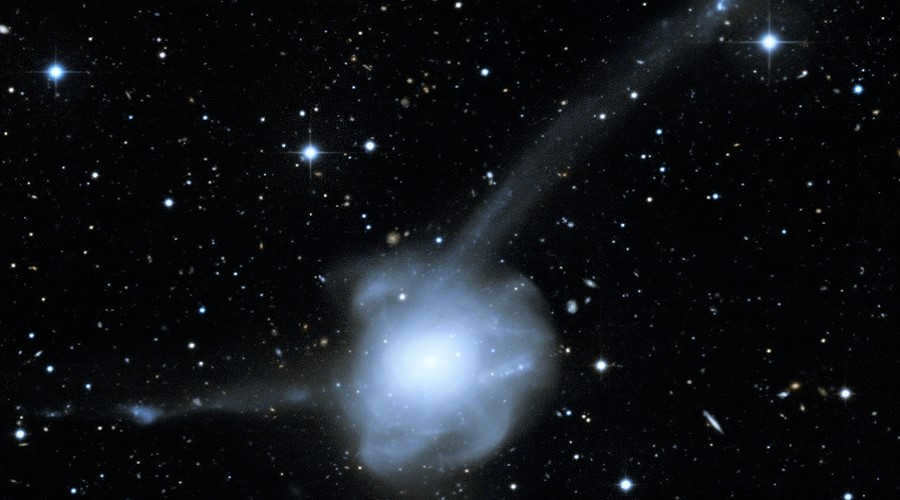
Aquarius is home to the Saturn and Snail nebulae, as well as multiple meteor streams.
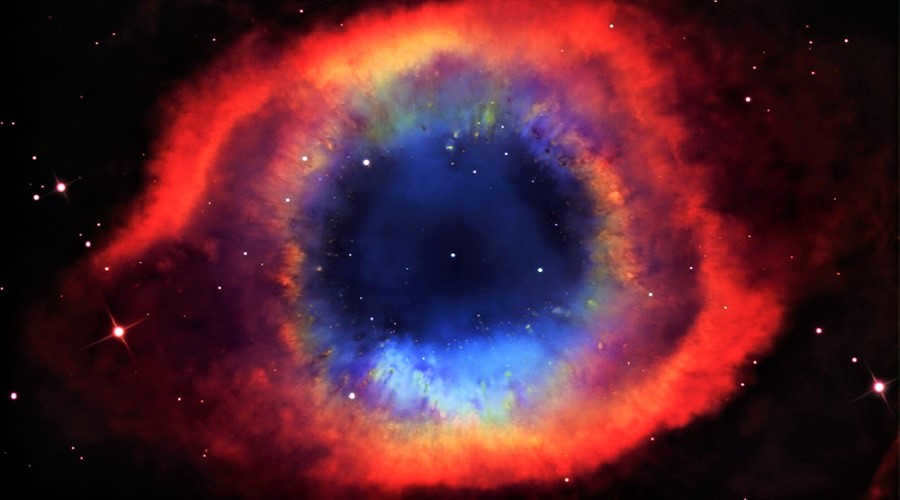
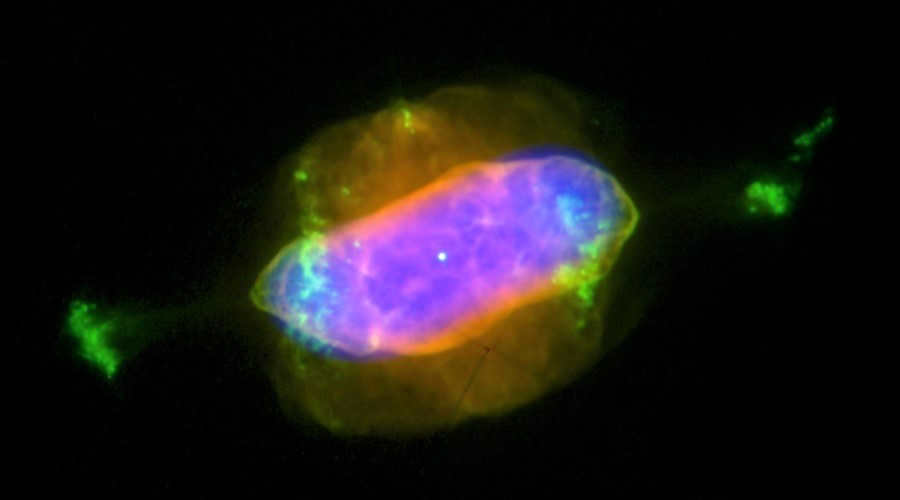
Observing
Observation of the Aquarius constellation is best done at latitudes ranging from +65 to -87 degrees. Due to its location in the southern part of the sky, it can only be observed in the southern region or in the central part of the Russian Federation. It is advisable to avoid observing during the period from February 16 to March 11, as the Sun passes through Aquarius during this time. The most favorable time for observation is in August-September.
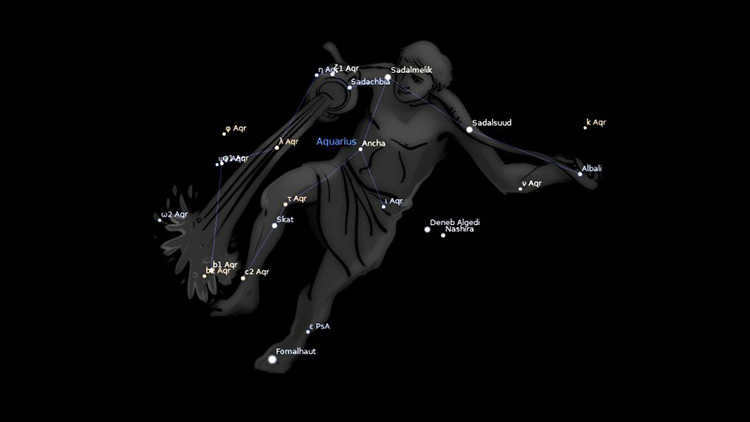
Aquarius is a constellation that was first identified by the Greek scientist Ptolemy in the 2nd century. It is the tenth largest constellation and covers an area of 980 square degrees. Aquarius contains numerous celestial bodies, nebulae, and meteor streams, and its boundaries are not clearly defined.
Observation Details:
- Aquarius is located in the “marine” section of the sky and is adjacent to the constellations of Whale, Dolphin, and Pisces.
- The constellation can be easily seen in the Southern Hemisphere during spring and in the Northern Hemisphere during fall.
- The best time for observing Aquarius in the central regions is during the months of August and September.
- The visibility of the constellation ranges from 65 to -90 degrees.
The biggest stars
Alpha
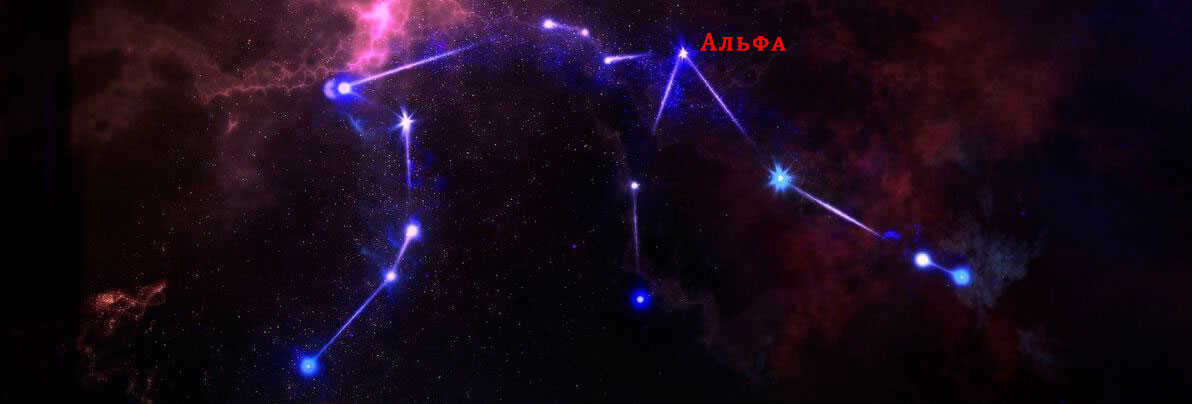
Alpha Aquarius, also known as “Sadalmelik,” is the second most luminous object in the cluster. It can be found in the shoulder area of the cupbearer. This celestial body is classified as a G-class supergiant, which makes it one of the rarest types of stars.
| Visible magnitude | 2.94 |
| Absolute magnitude | -3.882 |
| Radial velocity (km/s) | 7.5 |
| Rotation (km/s) | 17 |
| Temperature (K) | 5232 |
| Luminosity | 3000 times that of the Sun |
Supergiants are typically either red and cool or hot and blue. However, Alpha does not completely fit the profile of a yellow giant, many of which are cepheids with significant variability.
The atypical star is categorized by astronomers as a “hybrid” star. Research has indicated that the life cycle of Sadalmelik is currently in its concluding phase and it will expire in the near future.
Highly luminous stars generate powerful stellar gusts, whereas less bright stars possess magnetic fields that allow for the observation of a circular luminous “corona”. Despite its comparatively lower temperature, Sadalmelik possesses both of these characteristics.
Beta
Sadalsuud, also known as Beta of Aquarius, is the most luminous celestial object in the constellation. It has a radius 50 times larger than that of the Sun.
| Apparent stellar magnitude | 2.89 |
| Absolute stellar magnitude | -3.477 |
| Radial velocity (km/s) | 6.5 |
| Rotation (km/s) | 18 |
| Temperature (K) | 5465 |
| Luminosity | 23,000 times that of the Sun |
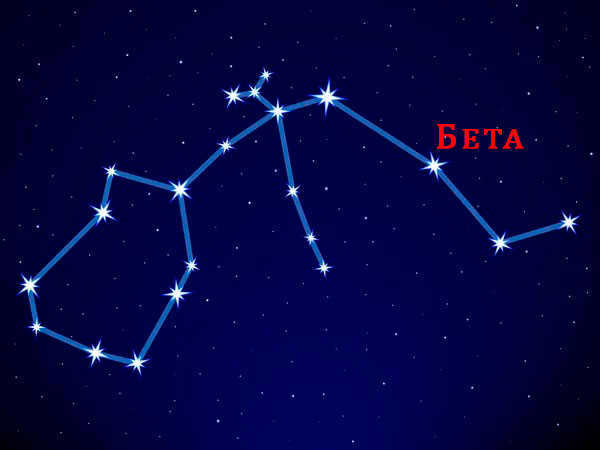
Referred to as a supergiant with a spectral class of GO, this star has a composition and some characteristics that resemble Alpha. Scientists believe that these stars were formed from different parts of a single gas-dust cloud.
Beta has a surface temperature that matches that of the Sun, but its brightness is much higher. Sadalsuud is the hottest of the three stars and has the strongest luminosity. Similar to Sadalmelik, it will soon follow an evolutionary path and become a massive white dwarf.
Although the star is comprised of three optical elements, there is currently no concrete evidence of a gravitationally-bound system.
Delta.
Delta is a bright star located 160 light-years away from Earth. It belongs to the spectral class A3, which means it emits a white light.
| Apparent stellar magnitude | 3.28 |
| Absolute stellar magnitude | -0.17 |
| Radial velocity(km/s) | -24.21 |
| Rotation(km/s) | 83.2 |
| Temperature(K) | 7998 |
| Luminosity | 40 |

Delta has a mass that is twice the size of the Sun and a surface temperature that is one and a half times hotter than the Sun. Recent studies have shown that the star has a companion with an orbital velocity of 490 days.
There is a possibility that Delta is a part of the Big Dipper constellation. Additionally, this celestial body is linked to a meteor stream that is observed in July and August. It is in this stream that Halley’s Comet can be seen.
Delta is also known as Scut, which translates to “thigh” in Arabic. This name reflects the star’s position on the diagram of the system’s pattern.
Other stars that are known:
- R Aquarius is situated 650 light years away from our planet. This unique system consists of two parts – a red giant and a white dwarf. The white dwarf, through the force of gravity, absorbs materials from its neighboring star. The area surrounding R Aquarius is enveloped in a cloud of dust.
- 91 Aquarius is an orange giant that exists within a triple system, located 150 light years away from Earth. The companion is a binary star, with both components being extremely massive and in close proximity to each other.
- Gamma is a spectroscopic star with a double system. It is positioned 158 light years from Earth. In the diagram, Gamma can be found in the forearm region of Aquarius. Its alternative name, Sadahbiya, translates from Arabic as “good luck in the house”.
- Zeta is a binary star system located approximately 100 light-years away from our planet. Zeta 1, the primary star, is a yellow-white giant, while its companion, Zeta 2, shines even brighter. Zeta 2 is classified as an F-type yellow-white dwarf.
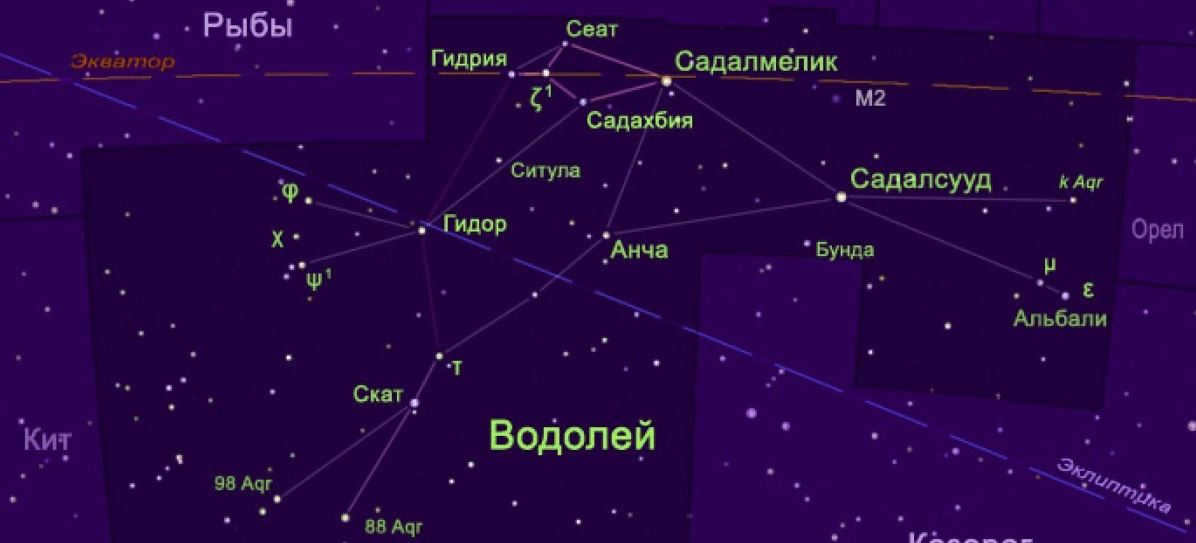
Meteor streams
The most ideal time to observe flying meteors is during the early morning hours of a cloudless night, away from any sources of artificial light. By using a telescope with low magnification, it is possible to observe up to five radiant meteor streams. Each stream is named after the constellation from which the meteor shower seems to originate:
Eta Aquaridae
The Eta Aquarid meteor shower is an annual event that occurs in May. It is associated with Halley’s Comet and is named after the constellation Aquarius. This meteor shower is known for its fast-moving meteors and has been observed for centuries. During its peak, which usually falls around May 5th and 6th, skywatchers can expect to see up to 30 meteors per hour. The Eta Aquarids are best viewed from the southern hemisphere, although they can still be seen from the northern hemisphere. To observe this celestial event, find a dark location away from city lights and allow your eyes to adjust to the darkness. Look towards the east in the early hours before dawn, and you may be treated to a spectacular display of shooting stars.
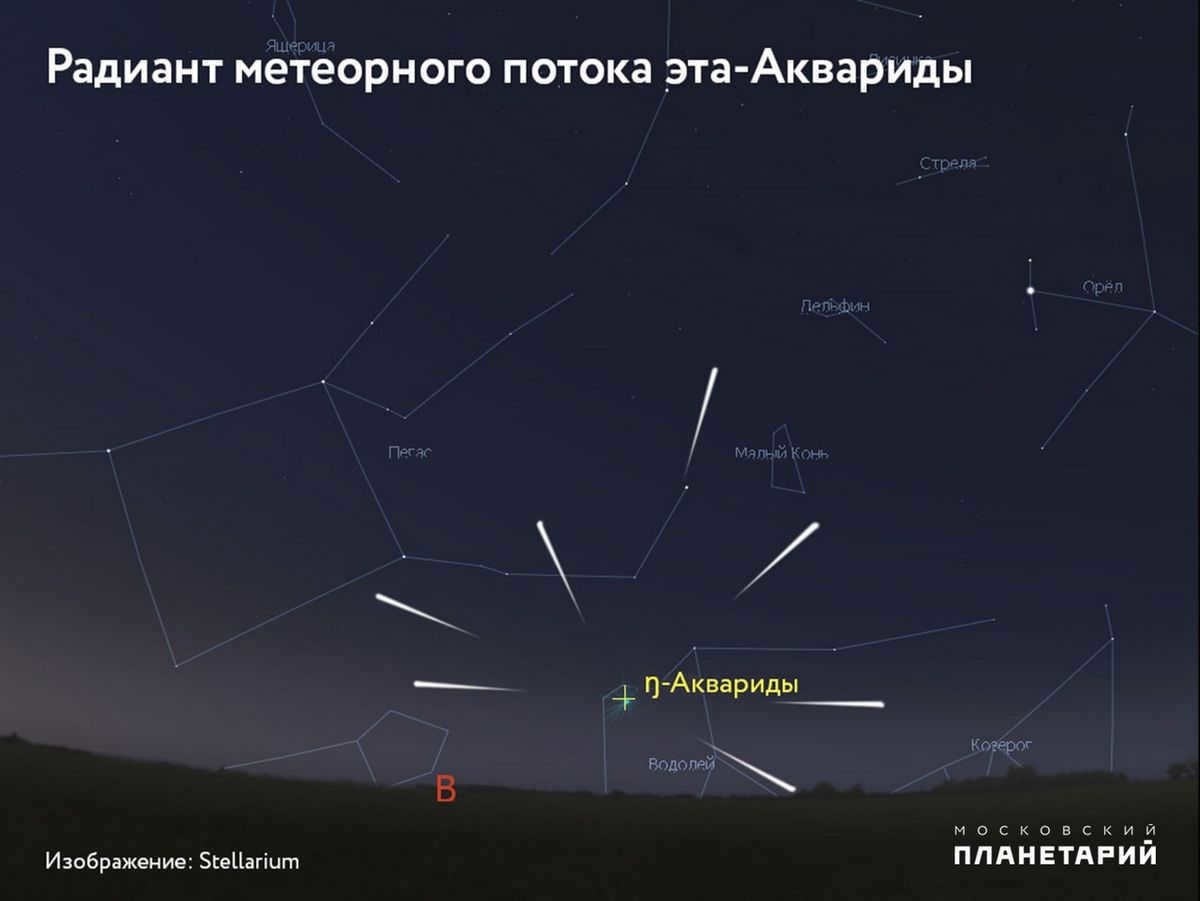
To witness the region formed by the tail of Halley’s Comet, there are two most auspicious months – the conclusion of April and May. The utmost clarity occurs during the interval spanning from May 1 to May 8.
The intensity of Eta Aquarides reaches 40 shooting stars per hour, soaring at velocities of up to 66 km / s. The radiant is situated in proximity to Beta Aquarius, in the Southern Hemisphere, and does not ascend significantly. Visibility from higher latitudes is limited.
Delta Aquaridae:
- Southern – the period of visibility commences in mid-July and concludes by August 15. The most opportune night for observation is July 29. The flux density peaks at 14 shooting stars per hour.
Iota aquarids:
- Southern – the observation window for this meteor shower is from July 15 to the end of August. The peak activity occurs on August 5, with meteors appearing at a rate of 10 per hour.
- Northern – these meteors are located near Teta Aquarius. They can be seen from August 10 to September 10. Similar to the Delta Aquarids, there is a period where both meteor showers overlap.
Fascinating celestial formations
Snail Nebula
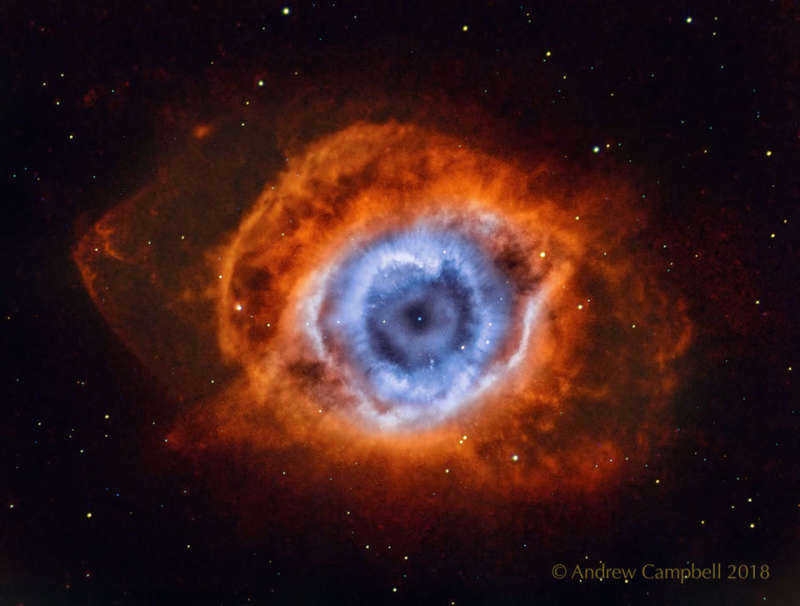
Known as the unofficial moniker “The Eye of God,” this nebula in the Aquarius constellation bears a striking resemblance to a human eye that could have been painted by an Impressionist artist. It holds the distinction of being the largest nebula in Aquarius and is located a mere 650 light years away from Earth. Scientists estimate that it is approximately 10,600 years old, and it formed after the explosion of a star similar to our Sun. In the center of the nebula, a white dwarf remains, casting its illuminating light upon the cosmic dust that surrounds it.
Saturn
is the sixth planet from the Sun and the second-largest in the Solar System, after Jupiter. It is a gas giant with an average radius about nine times that of Earth.
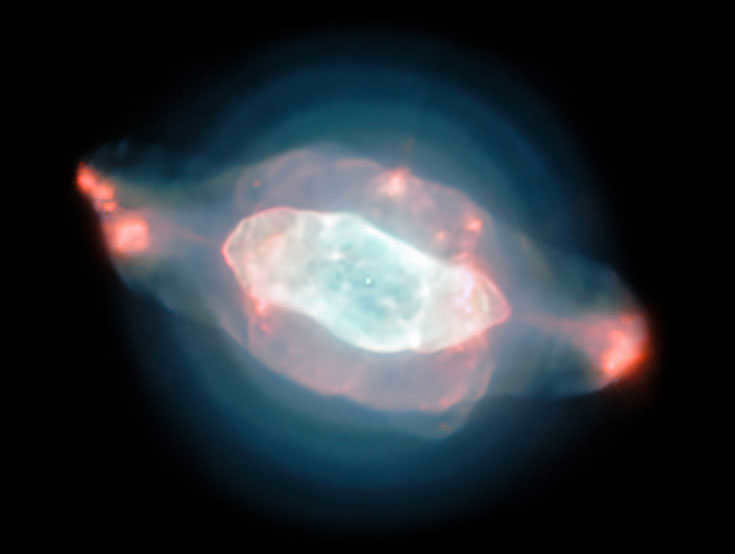
The Saturn Nebula got its name from its unique shape – a spherical center encircled by a planetary ring. This intricate system consists of a halo, shells, multiple jet streams, and other elements. Situated 1 degree west of New Aquarius, the nebula is centered around a white dwarf with a scorching surface temperature of 55,000 degrees Celsius.
Messier 2
can be paraphrased as follows:
The second object in the Messier catalog
.
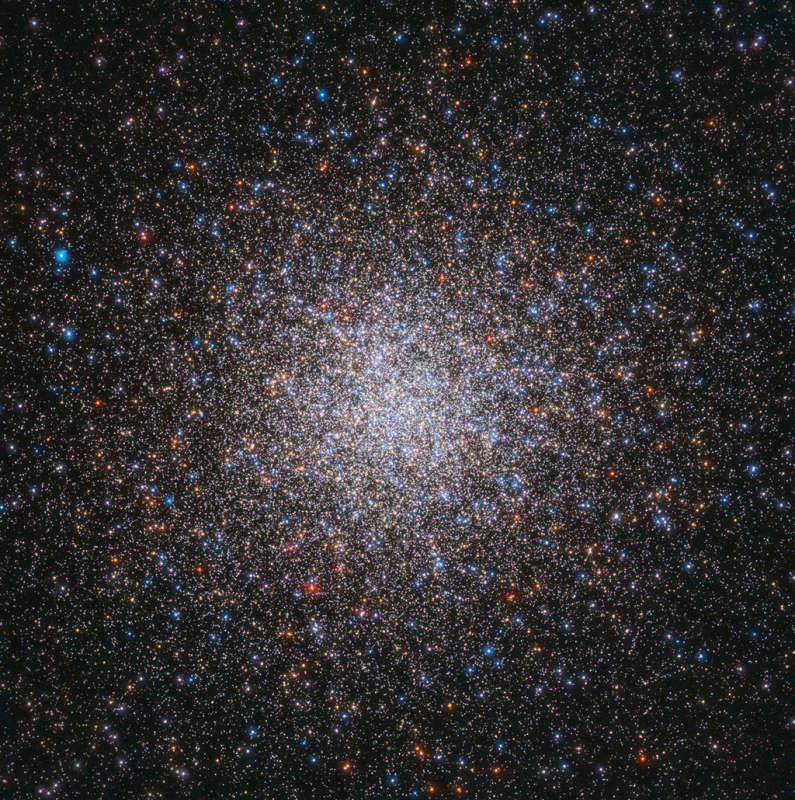
Messier 2 is a compact star cluster that is known for its intense brightness. With a diameter of just 175 light-years, this cluster is home to 150 thousand stars. Its circular shape and prominent central point make it easily observable with a regular telescope.
Interestingly, when Jean Maraldi discovered Messier 2 in 1746, he described it as a “nebula without stars”. It wasn’t until 14 years later, when astronomer William Herschel made his observations, that the true nature of this cluster became known.
The constellation Aquarius has long been regarded as a representation of the vitalizing essence of moisture in various civilizations. For instance, the Sumerians linked it to the deity An, who bestows rain upon the terrestrial realm. In Latin, the name Aquarius bears a resemblance to “cupbearer”.
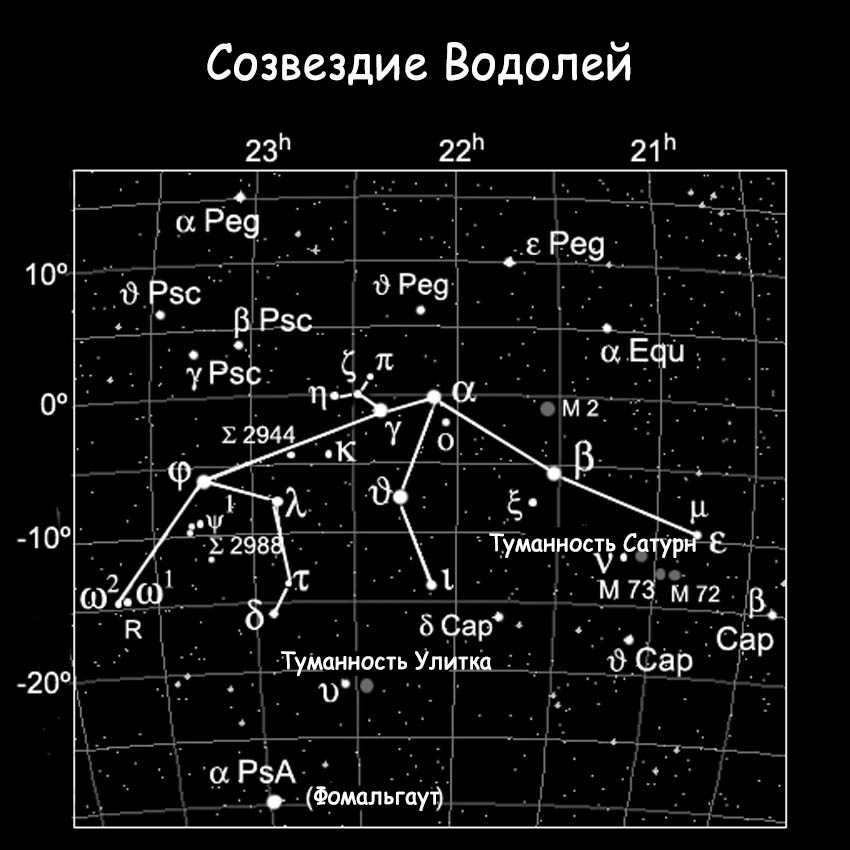
In ancient Greek astronomy, Aquarius was represented as a youthful male pouring wine from a pitcher. According to a myth, the inspiration for this depiction was Ganymede, the unloved son of the king of Troy. Zeus elevated Ganymede to Olympus and granted him eternal life. Ganymede then served the gods by filling their goblets with nectar.
Aquarius is a constellation that captivates astronomers with its intriguing and enigmatic nature. It presents a remarkable array of celestial objects, including stars and nebulae, which hold significant scientific value for study and exploration.
Q&A
Aquarius can be easily seen in the Southern part of Aquarius, right on time for the start of the rainy season.
Pegasus, Capricorn, Sculptor, Eagle, and Lesser Horse are located nearby.
Sadalmelik is an Arabic word that translates to “the king’s happiness.” And Sadalsuud means “the happiest of the happiest.”
Between February 16 and March 11.
Traditionally, the constellation is represented not only by a young man pouring water, but also by two wavy lines symbolizing the flow of water, both in life and in death.
Video review of fascinating entities within the Aquarius constellation
Aquarius is one of the twelve traditional zodiac constellations. This indicates that Aquarius lies along the ecliptic, which is the path of the Sun across the starry backdrop. The Sun passes through Aquarius each year from February 16 to March 11, a span of 24 days. It is also possible to spot planets within this constellation. In 2019, Neptune can be found in Aquarius. Given these factors, it is understandable that many individuals are curious about the location of Aquarius. Let’s explore how to locate the Aquarius constellation in the night sky.
Observing the Aquarius Constellation
Before considering where to direct your gaze, it is important to determine the optimal time for observation. As you may be aware, the arrangement of stars in the night sky gradually shifts towards the west at a consistent pace. Consequently, the constellations visible during winter evenings become obscured during the summer months, and vice versa. This celestial rotation is a consequence of Earth’s orbit around the Sun, as different constellations become visible when our planet’s night side faces them.
The Aquarius constellation is typically associated with the summer and autumn seasons. The ideal period for observation extends from August to November. During this timeframe, Aquarius reaches its highest point above the southern horizon in the evening sky.
However, this doesn’t imply that the constellation can’t be observed during other months. For instance, from May to July, the constellation can be seen in the morning and night sky towards the southeast and south, and in December and January during the early evening towards the southwest.
Where to observe.
Now that we have determined the best time to observe Aquarius, let’s find out where to look.
The elevation of Aquarius above the horizon is equivalent to the height of the Sun when it is in this constellation. It was mentioned earlier that the Sun is in Aquarius in late February to early March. As you may recall, during this time our daytime star is not very high in the sky. Therefore, when searching for Aquarius in the autumn evenings, it is necessary to look upwards only to locate reference points.
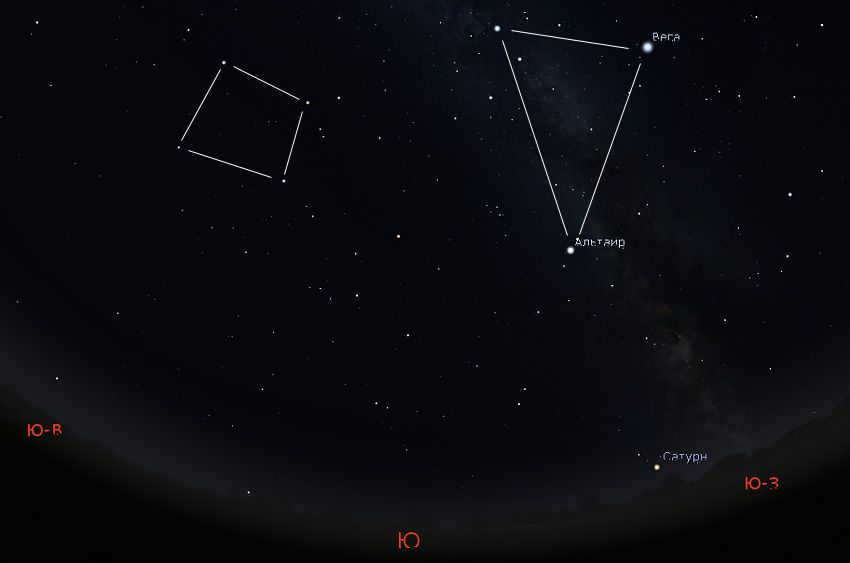
To locate Aquarius in the celestial sphere, one can use the following general algorithm.
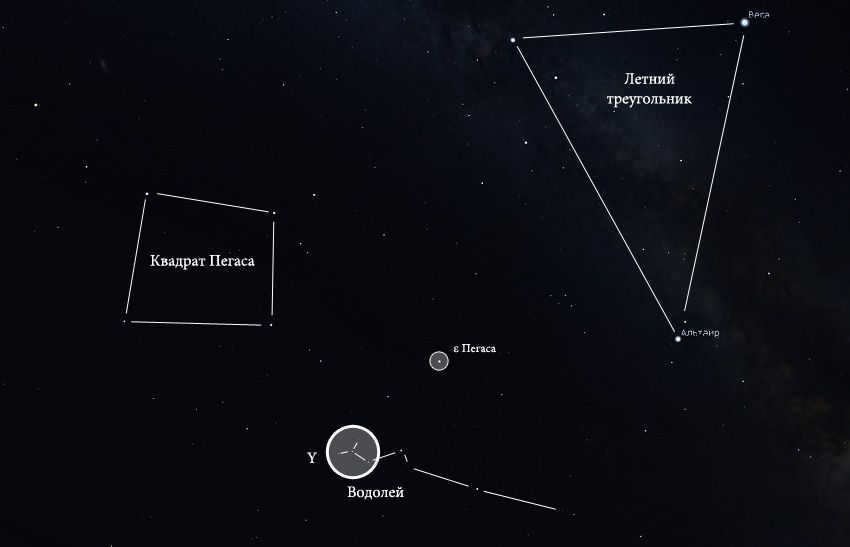
- During the evening hours between August and November, once it becomes dark, face south. In the sky above, you will be able to observe three bright stars that create the Great Summer Triangle. These stars are named Vega, Deneb, and Altair. The triangle points downward towards the horizon with a sharp apex, which is where you will find the star Altair. Altair is located at the apex of the triangle.
- Next, shift your gaze approximately 30 degrees to the east of the triangle (to the left). You will notice a square formation composed of four stars, which have a similar level of brightness as the stars in the handle of the Big Dipper. This square is relatively large in size, but smaller compared to the summer triangle.
- Observe the sequence of stars that extends towards the west from the lower right corner of the square all the way to the star Altair. These stars belong to the Pegasus constellation. The most brilliant star in this sequence is the epsilon star of Pegasus, positioned approximately midway between the square and Altair.
- Consequently, the region of the sky directly beneath this string of stars is occupied by the Aquarius constellation.
Illustration of the Aquarius Constellation
Aquarius, like many other constellations in the night sky, lacks a distinct pattern. One notable feature is the zigzag line of stars that runs from east to west, almost parallel to the horizon. This line includes the two brightest stars in the constellation, known as alpha and beta Aquarii, with a combined brightness of approximately 3m.
To the left, the line terminates with four stars of 4th magnitude, forming a shape resembling the letter Y. This small group of stars is referred to as the Y asterism.
The remaining stars of Aquarius can be found to the south of this line. They can be connected in various vertical chains, collectively resembling not a figure carrying a water jug, as depicted in ancient maps, but rather something akin to a cascading waterfall.
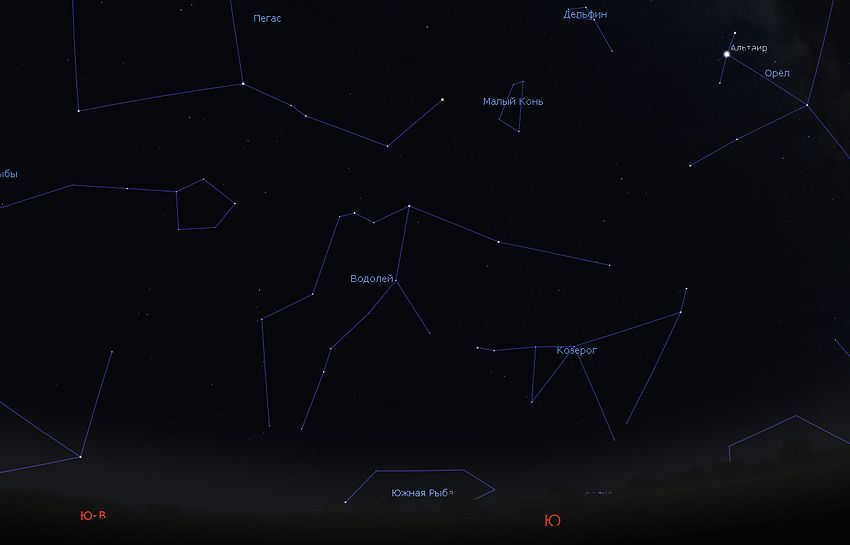
The constellation known as Aquarius has a rich history, dating back thousands of years. It was already recognized by ancient civilizations such as the Chaldeans and Babylonians over 3000 years ago. According to celestial researcher Ideler, this group of stars acquired the name Aquarius during the Middle Ages because the Sun appeared to be located within it during the rainy season.
Interestingly, Aquarius is surrounded by other constellations that have strong ties to water. To the east, we find Pisces, Cetus, and Eridanus. In the southern region, Aquarius is bordered by the constellation South Pisces, while to the northwest, near the Summer Triangle, lies the small constellation Dolphin. It is intriguing to ponder why so many constellations associated with the sea or water are concentrated in this particular area of the sky.
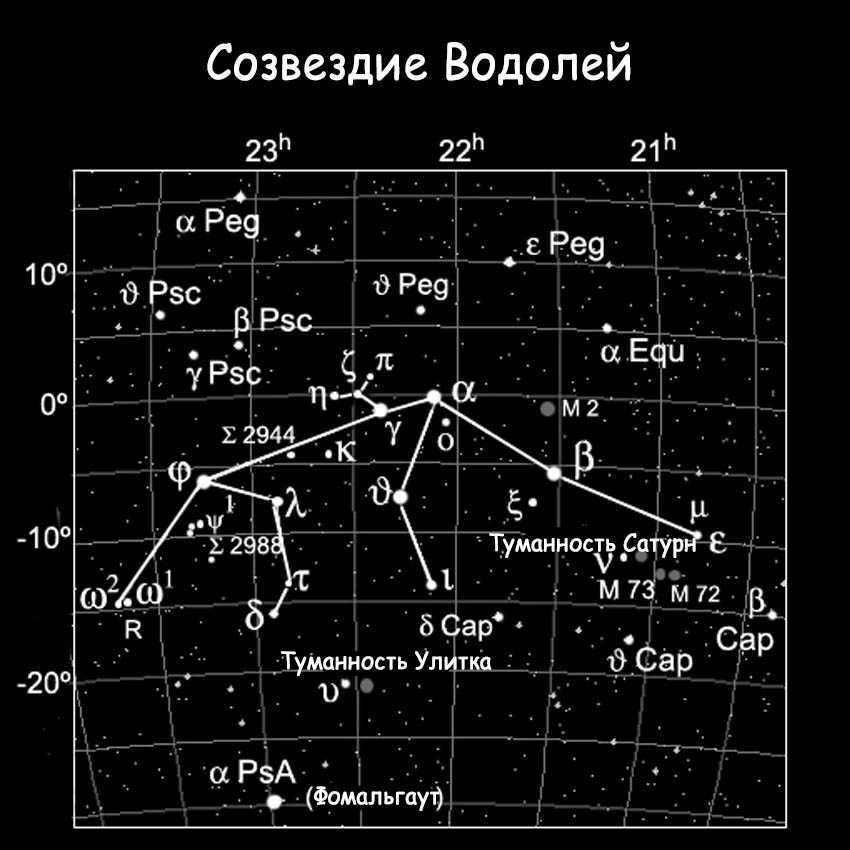
Primarily recognized as one of the twelve zodiac signs, the Aquarius constellation is familiar to most individuals. Positioned along the Sun’s trajectory, this constellation resides among the remaining eleven constellations within the zodiacal belt.
Discover the Aquarius constellation: its features, location, and optimal viewing period
From February 16 to March 11, the Sun graces the Aquarius constellation, while the best time to observe this stellar formation is in August and September. If you reside in the central or southern regions of Russia, you have the fortunate opportunity to witness the Aquarius constellation in all its magnificent splendor during this period.
Constellation’s Position in Space
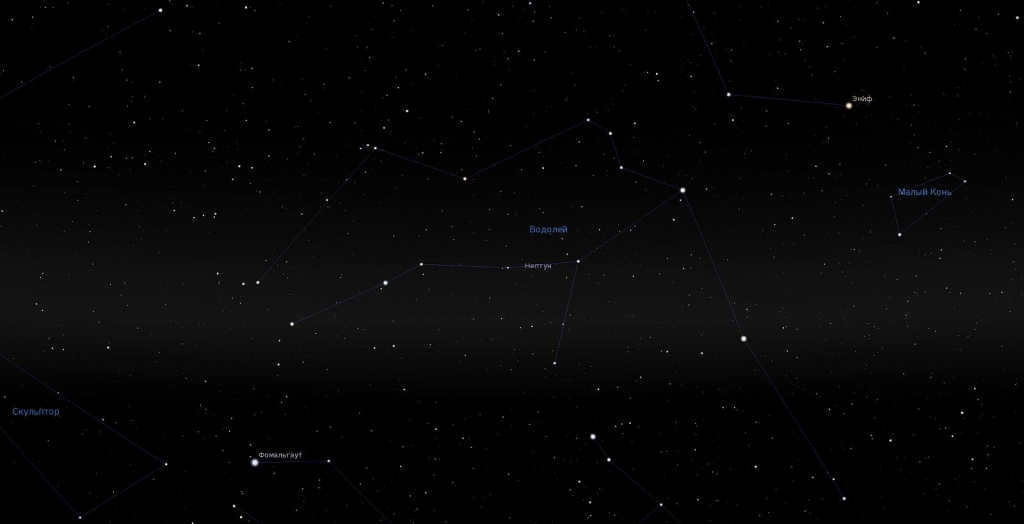
Observing the constellation in the planetarium software.
What is the territorial location of Aquarius? When it comes to its zodiacal position, traditionally it is located between Capricorn and Pisces. Aquarius is situated in the southern hemisphere of the celestial sphere, surrounded by various aquatic constellations such as Cetus, Delphinus, Eridanus, and others. This region is often referred to as the sea due to the presence of these water-related constellations. Aquarius, known as such by the ancient Greeks, is one of the oldest and largest constellations. More precisely, it occupies an area of 980 square degrees in the night sky, ranking it in tenth place.
The Count of Stars in the Aquarius Constellation
On a moonless and clear night, an observer can easily spot approximately 90 stars within the Aquarius constellation. It is important to note that out of these ninety stars, only seven have a stellar magnitude exceeding four. These seven stars create a distinctive curved arc, with five of the brightest stars concentrated in the center. This grouping of stars resembles a prototype of a jug with a stream of water flowing from it. Although it may not be immediately apparent, this arrangement of stars represents a young man with a jug of water, as depicted in ancient star atlases.
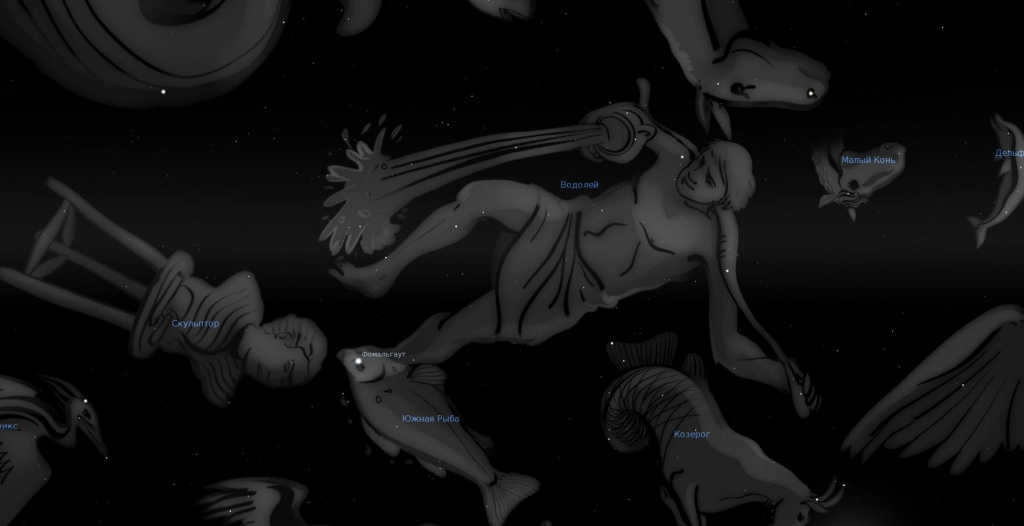
The reason why this particular image came to represent the constellation of Aquarius is rooted in the observations made by the ancient Greeks. They noticed that during the autumn season and the onset of the rainy period, the constellation became clearly visible in the southern part of the horizon. This recurring phenomenon led the Greek ancestors to associate Aquarius with a young man who would kneel down and pour water from a jug onto the earth. This depiction, created in ancient times, has endured throughout the years.
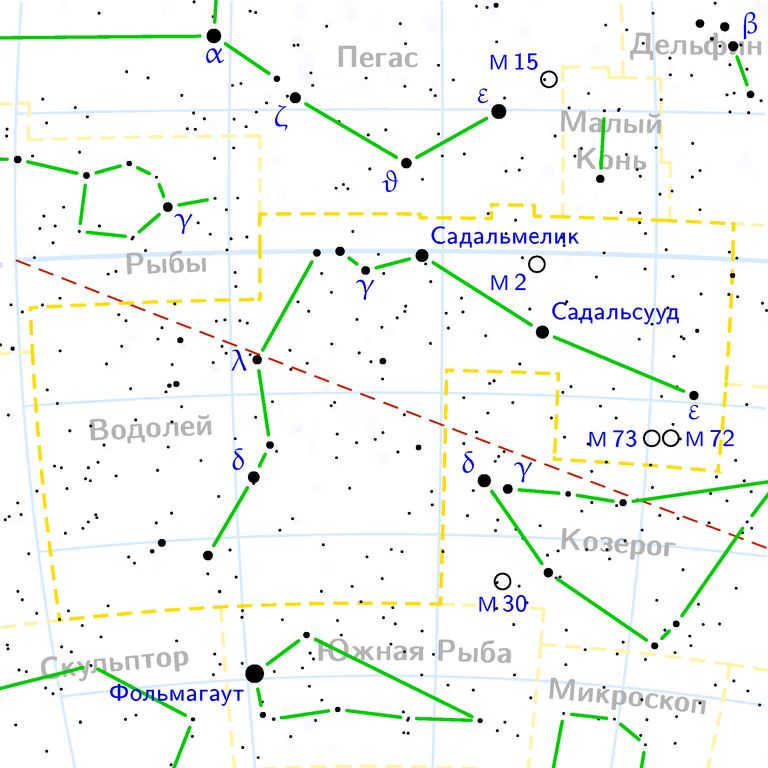
Diagram The brightest stars of the constellation Aquarius.
The most notable stars in this constellation are the Alpha, Beta, and Delta of Aquarius. Let’s begin the tale with the first star, not in alphabetical order, but by brightness, known as Sadalsuud (aka beta Aquarius). Like many celestial objects, this unique name of the star comes from the Arabic language and translates to “happy among the happiest”. The name carries a philosophical tone, but its meaning is straightforward: the Sun enters Aquarius precisely at the moment when winter transitions to spring, and the season of refreshing spring showers begins outside our windows.
Sadalsuud
Sadalsuud, also known as Beta Aquarii, is a star in the constellation Aquarius. It is the brightest star in the constellation and the 25th brightest star in the night sky. Sadalsuud is a blue-white supergiant star located approximately 540 light-years away from Earth. It has a radius that is around 36 times that of the Sun and is estimated to be about 2.5 times more massive than the Sun. Sadalsuud is classified as a variable star and its brightness can vary by about 0.1 magnitudes. It is also a spectroscopic binary star, meaning it has a companion star that orbits around it. The companion star is much fainter than Sadalsuud and is not visible to the naked eye.
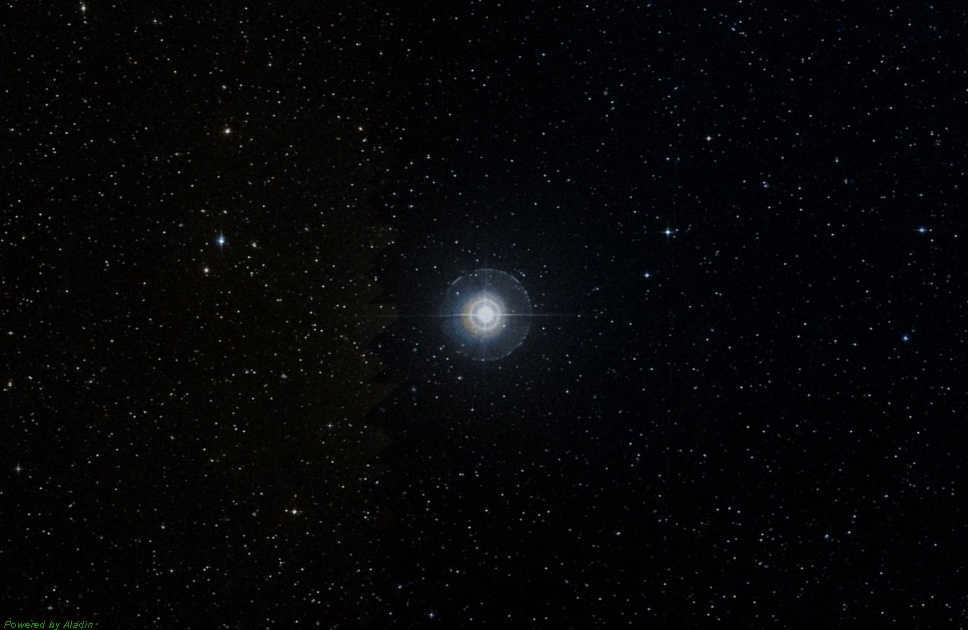
Photograph of Beta Aquarius or Sadalsuud
Sadalsuud is an uncommon star with a third magnitude, meaning its brightness is 2.91m. This particular celestial object is classified as a hot supergiant, making it quite rare. It falls into the G0 spectral class and has a surface temperature similar to that of the Sun, around 5600 K. Beta Aquarius is located approximately 600 light years away from Earth and has a luminosity 2200 times greater than that of the Sun. Sadalsuud also has some advantages over the Sun, including a diameter about 50 times larger and a mass equivalent to six Suns.
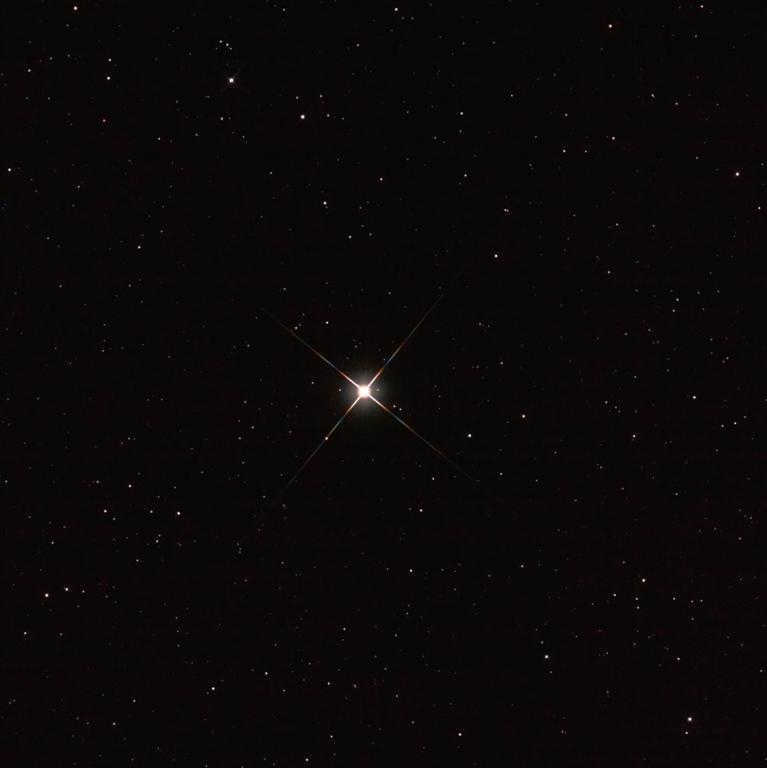
When observed through a telescope, Sadalsuud appears as a triple star. Aside from the main star, beta Aquarius proper, there are two other noteworthy optical components. The first component, Beta Aquarius B, is located about 35 angular seconds away from the host star and has a stellar magnitude of 11.0m. The second component, beta Aquarius C, is situated 57.2 angular seconds away from the host star and has a stellar magnitude of 11.6m. However, it is unfortunate that there is currently no confirmation of these stars being gravitationally bound as a triple system. It is highly likely that they are simply a visually observed triple system.
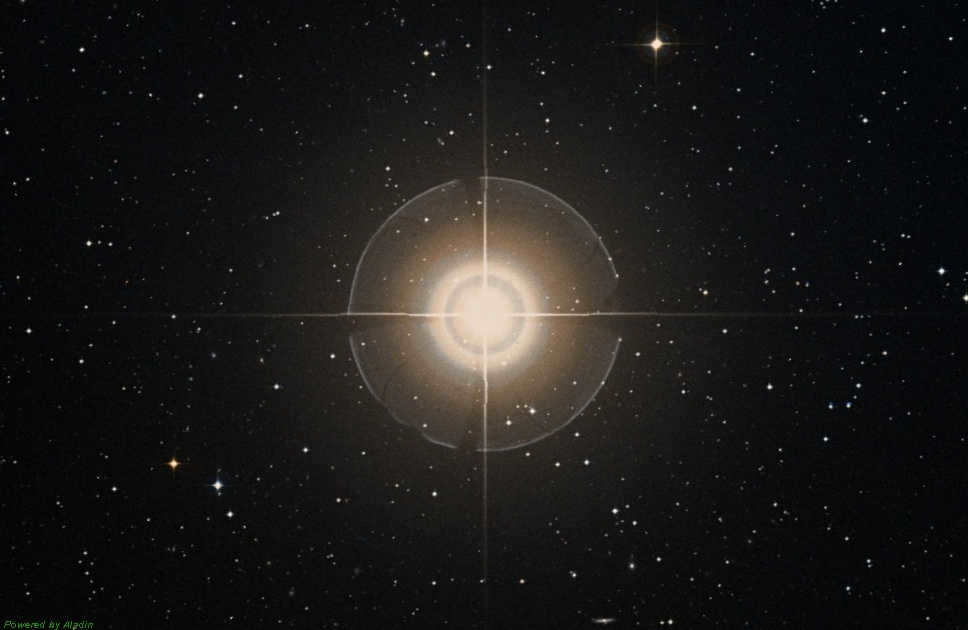
Image of Alpha Aquarius or Sadalmelik
Sadalmelik, the second brightest star in Aquarius after Sadalsuud, has a slightly lower brightness than Beta Aquarius. Like many other stars, Sadalmelik derives its name from Arabic. The name Alpha Aquarius signifies a “fortunate star of the king.” It has a visible magnitude of 2.96m and belongs to the G2 Ib spectral class. In the depiction of the constellation, this celestial body is located on the right shoulder of Aquarius.
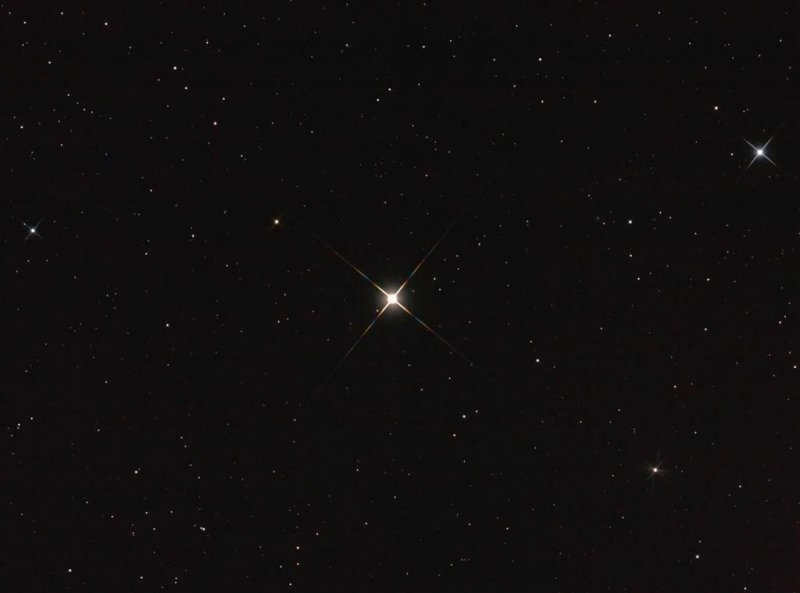
Sadalmelik stands out as a rather extraordinary star for a few reasons. To begin with, it falls into the category of a yellow supergiant. Sadalmelik’s surface temperature is just a few degrees lower than that of the sun, at 6000 K. It’s worth noting that encountering a yellow supergiant in the night sky is quite fortunate, as most of the known large stars in astronomy are either hotter (resulting in a blue color) or cooler (resulting in a red color).
The distance between Earth and Sadalmelik is 750 light-years. By making simple calculations, we can determine that its luminosity is 3000 times higher than that of the Sun, while its diameter is only 60 times larger. Although these numbers are impressive, Sadalmelik is considered a star of moderate size, unlike true supergiants that can encompass the entire orbit of Jupiter. The classification of supergiant implies that, based on stellar evolution, Sadalmelik is nearing its inevitable end.
Aquarius’s third brilliant element
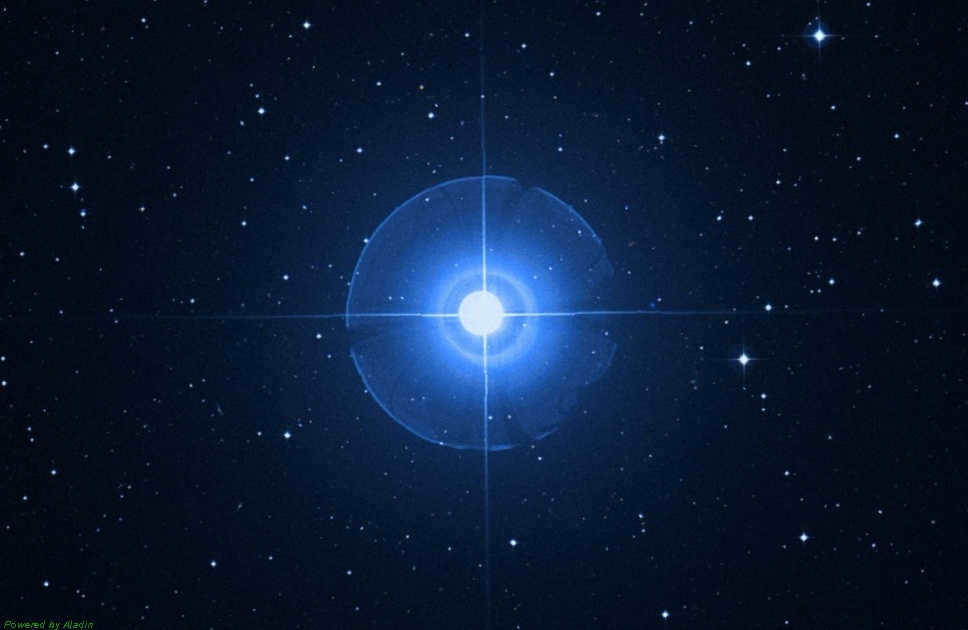
Photograph of Delta Aquarius or HD 216627.
Ranking third in terms of brightness after Sadalsuud and Sadalmelik is the delta of Aquarius. It is more commonly known as Scat, which can be translated from Arabic as “thigh”. This name is fitting, as the star is situated on the leg of Aquarius. The star has a visible magnitude of 3.27m and belongs to the A3V spectral class. It is located 160 light years away from our planet.
Scutus is a blue-white star. Delta Aquarius is categorized as a main sequence star within its spectral class. Based on the distance of the central star in the system, its spectral class, and its luminosity, it appears to bear a resemblance to the beta star in the Leo constellation. There is a possibility that Scut is a constituent member of the moving group of luminaries in the Big Dipper constellation.
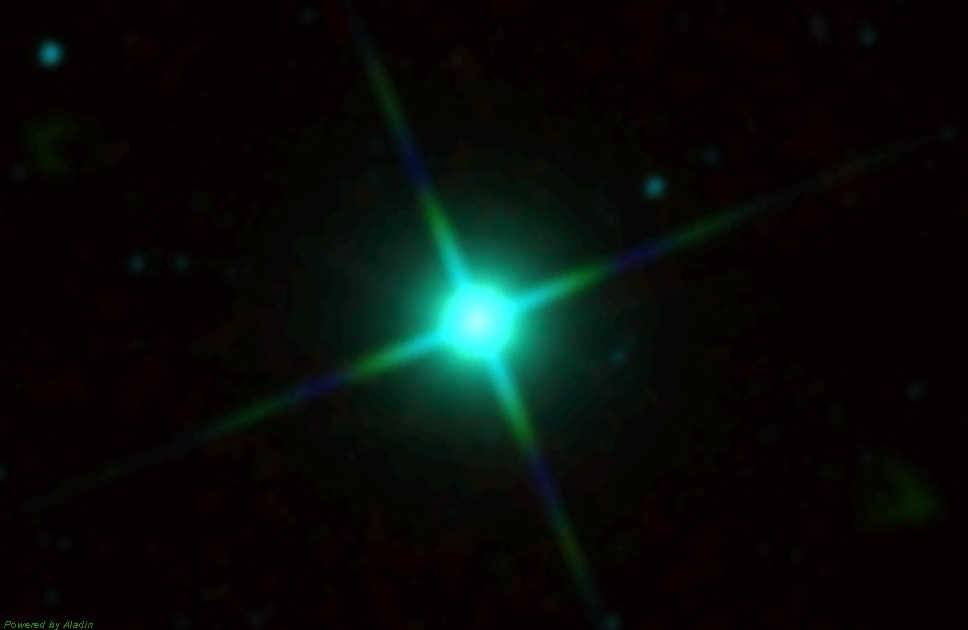
This photograph shows the Delta Aquarii star captured by the WISE telescope. When comparing this celestial body to the Sun, it is important to note that Scutus has a mass that is approximately double that of the Sun. Additionally, the star has a surface temperature of 9000 K and a radius that is about two and a half times larger than the Sun’s radius. Recent spectroscopic studies have indicated the possible existence of a companion star in the Delta Aquarii system. If confirmed, the orbital period of this companion star could be around 490 days.
Meteor showers in the Aquarius constellation
Regrettably, the Aquarius constellation lacks visible stars for observation through a regular telescope. However, it offers an opportunity to observe five different radiant points of various meteor showers. Let’s delve into each of them.
this Aquarids
can be rephrased as
the Aquarids of this year
.
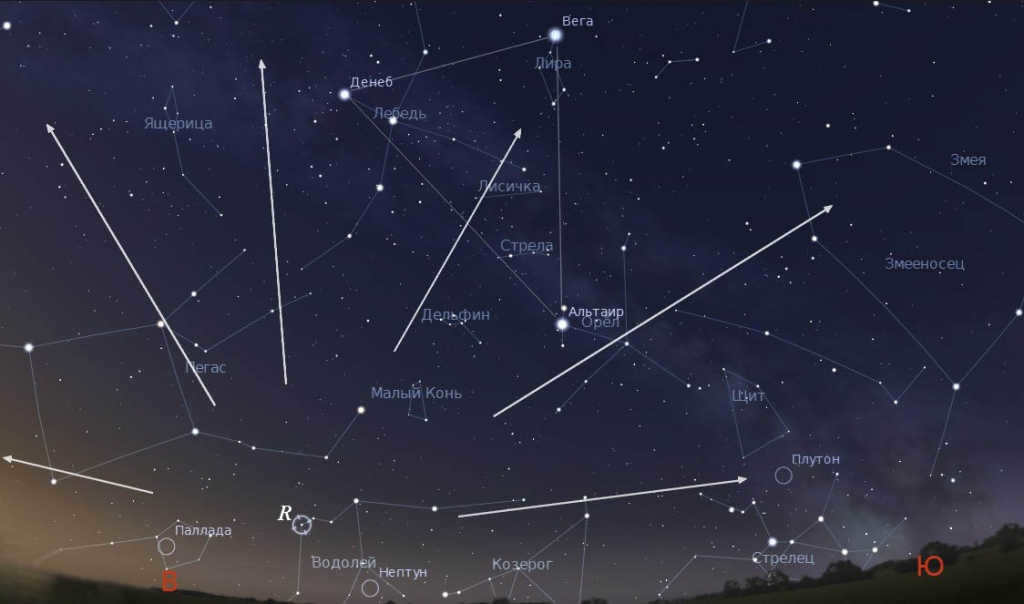
The first meteor shower to appear is known as Eta Aquarides. This collection of shooting stars can be found near the beta star of the Aquarius constellation. It is visible from May 1 to May 8, and can even be seen with binoculars. The peak of this meteor shower occurs on May 5, during which time you can expect to see around 36 meteors per hour. Eta Aquarides is often associated with the famous Halley’s comet, which was the brightest comet of the 20th century. As Halley’s comet gets closer to the Sun, the meteor shower becomes more intense, making it a subject of great interest for scientific observation and study.
The Southern Delta Aquariids Meteor Shower
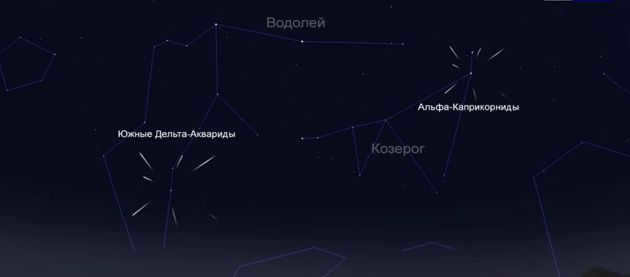
In close proximity to Delta Aquarius, there is another dazzling display known as the Southern Delta Aquarids. These meteors can be observed from around July 15 to August 15, with the peak occurring on July 29. During this time, it is possible to witness approximately 14 meteors per hour.
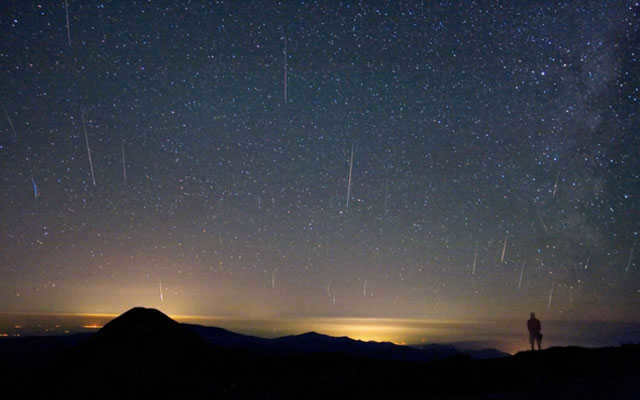
A photograph of the Northern Delta Aquarids was captured using a slow shutter speed.
In the same vicinity, near the Aquarius delta, lies another meteor stream known as the North Delta Aquarids. Its observation period and peak coincide with those of the Southern Delta Aquarids. However, the hourly rate of meteor showers from the Northern Stream is considerably lower. From a scientific perspective, the simultaneous observation of these two meteor streams holds great significance. It allows for the identification of unique structural characteristics that define each stream.
The Southern Iota Aquarids
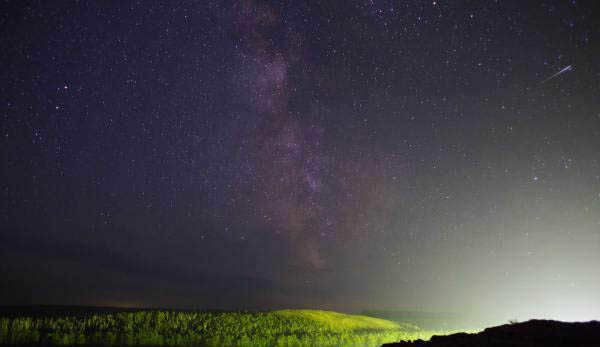
In the vicinity of the stellar object yot Aquarius, there is another fascinating source of the Southern yot Aquarids. Typically, it is witnessed from 15.07 to 25.08. The phenomenon reaches its maximum on August 5, during which period approximately 10 shooting stars can be observed every hour by anyone.
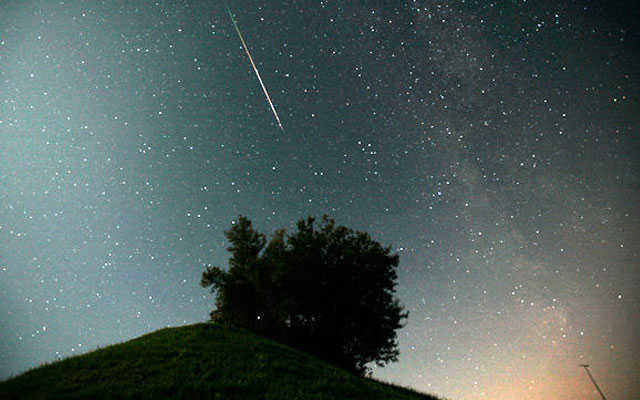
Picture of the Northern Iota Aquarids
From August 11 to September 10, stargazers have the opportunity to witness the mesmerizing Northern Iota Aquarids meteor shower in the Aquarius constellation. This radiant is positioned close to theta Aquarius, another prominent star in the region. By observing both of these meteor streams in conjunction, astronomers can gain a deeper understanding of the unique characteristics and formations of each radiant.
Engaging and extraordinary items found within the constellation
The Nebula resembling a snail
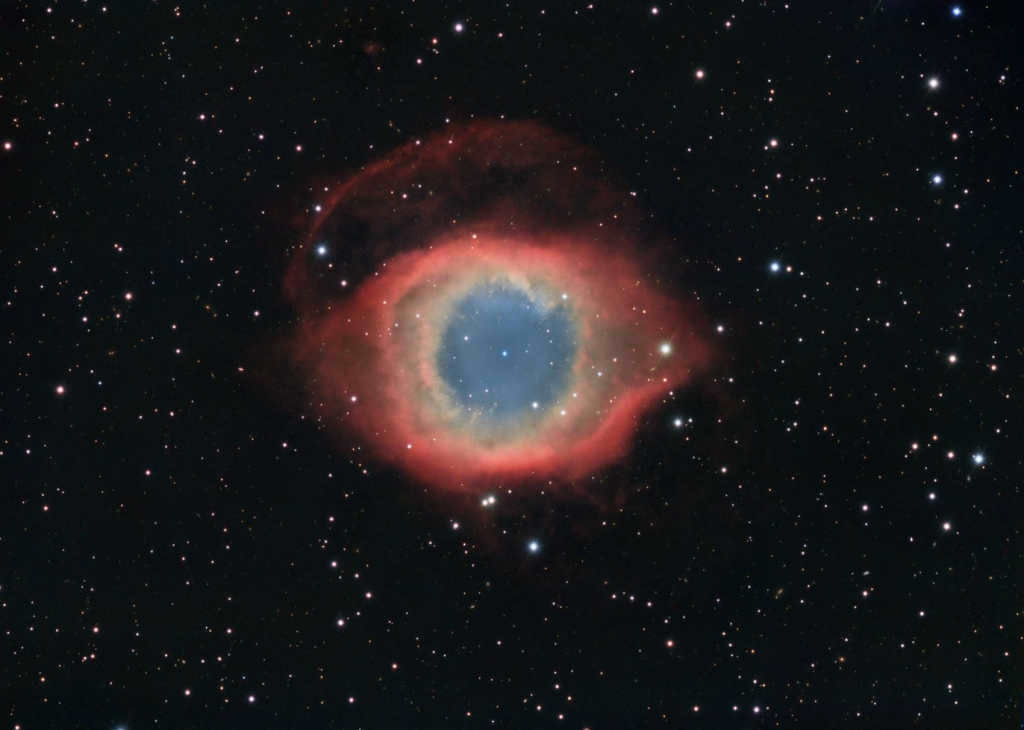
Amateur photo showcasing the Snail Nebula
Within the Aquarius constellation, besides the presence of stars and meteor streams, one can also observe globular clusters and nebulae. A notable example is the Snail Nebula, formally known as NGC 7293.

The photo depicts a magnified view of the gas droplets within the Snail Nebula.
As the largest and closest nebula to Earth, the Snail Nebula boasts an integral luminosity of 6.5m, making it easily visible through binoculars. With an angular size just twice that of the Moon, NGC 7293 is located a distance of six hundred light years from our planet. At the heart of the Snail Nebula lies a star with a scorching temperature of 60000 K, which serves as the primary source of illumination for the surrounding nebula.
Collection of images showcasing the Snail Nebula:
NGC 7089
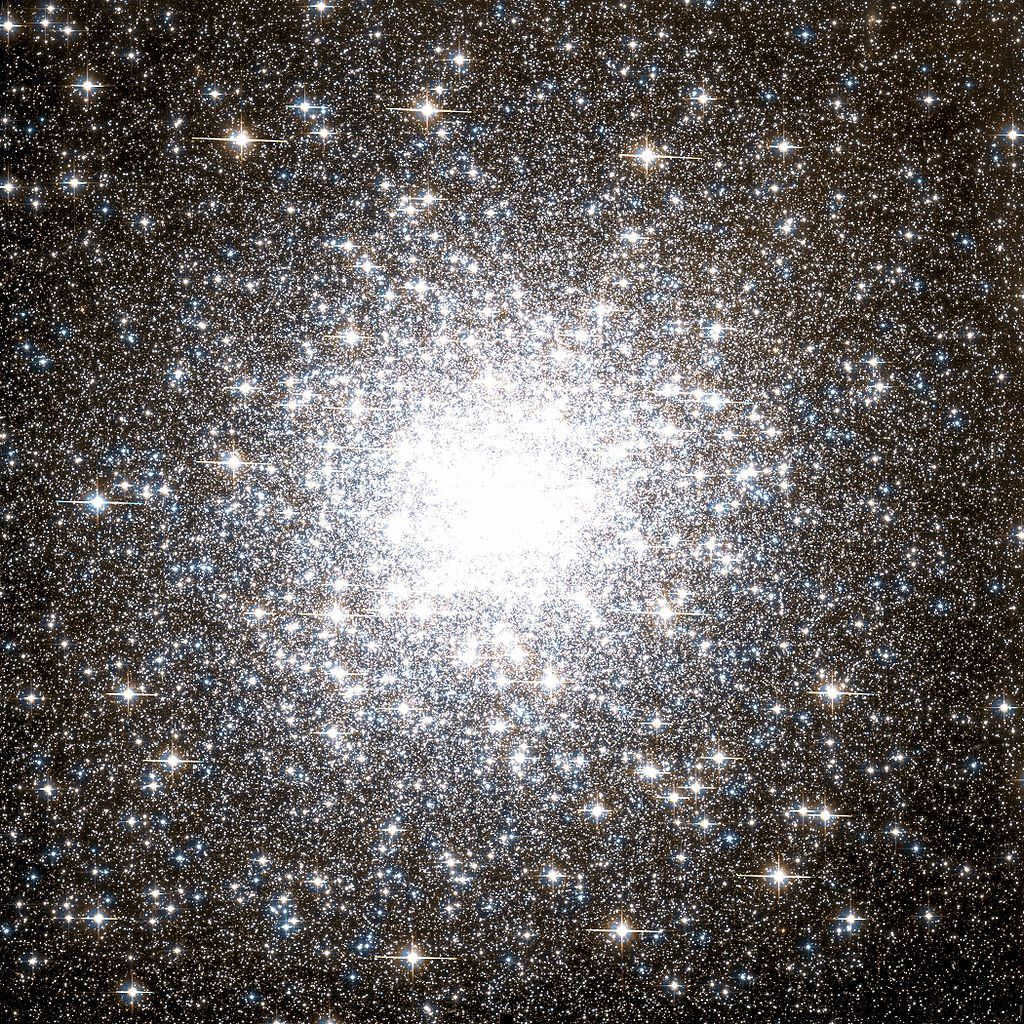
Another remarkable feature in the constellation of Aquarius is the globular cluster M2 (also known as Messier 2 or NGC 7089). It is worth noting that this cluster can be observed from Earth without the need for any optical instruments. Despite its significant “density” – with 150,000 stars in the globular cluster, it is considered relatively compact, with a diameter of around 175 light-years. Interestingly, the M2 cluster was independently discovered in 1746 by two scientists, J.D. Miraldi and Ch. Messier. The latter included it in the stellar catalog as a nebula with no stars. It was only 11 years later that stars were found within it, which were observed by W. Herschel.
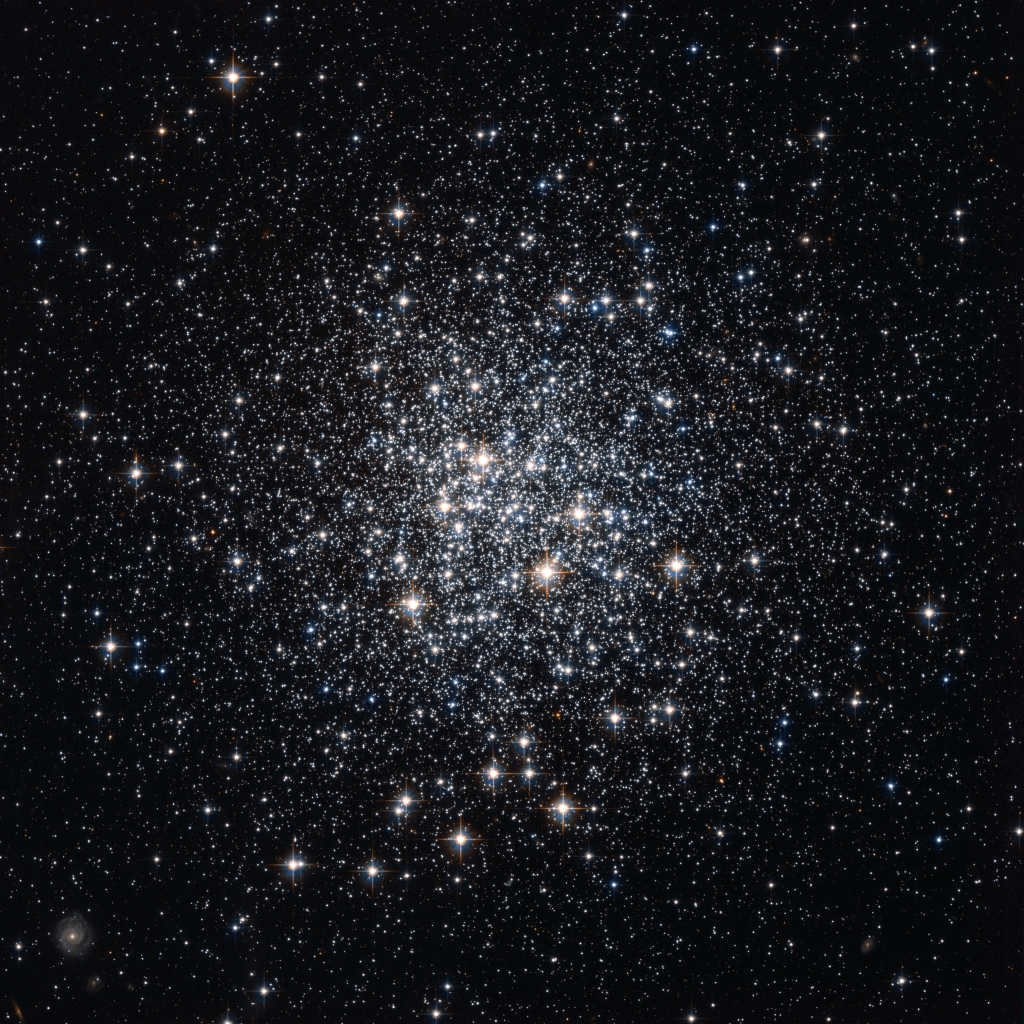
Aside from M2, Aquarius boasts a number of other captivating nebulae, including the M72 cluster or NGC 6981. This particular cluster stands out as the most elusive and faintest within the constellation, making it a challenging sight to behold even with a powerful telescope. Situated beyond the central region of our galaxy, the M72 star cluster is positioned a staggering 53 thousand light years away from Earth.
M73 cluster scattered in space
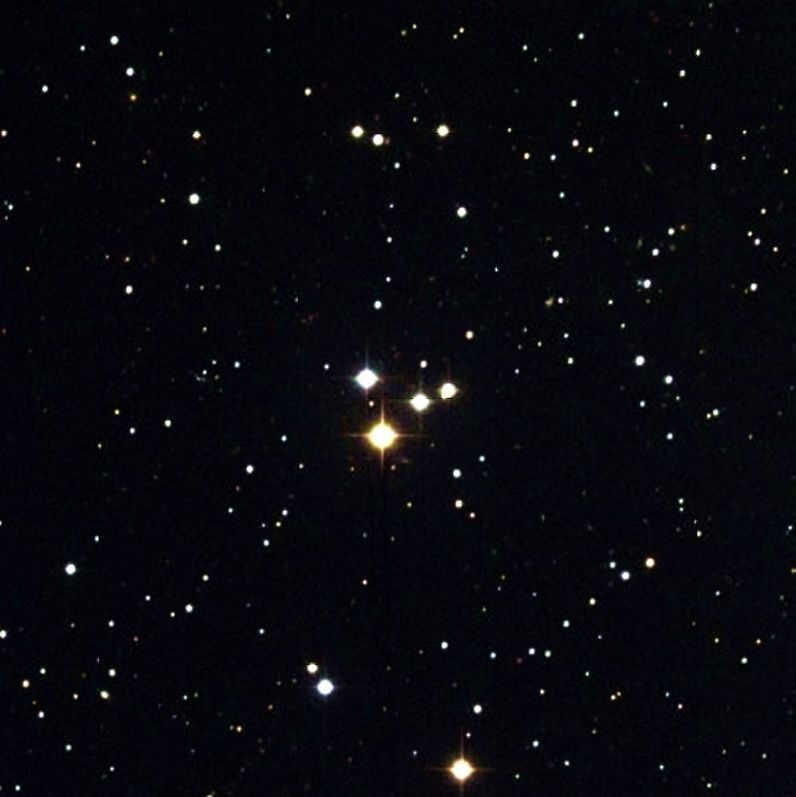
Picture of Dispersed cluster M73
Adjacent to this globular cluster lies another one – M73. This cluster is alternatively known as NGC 6994 or OCL 89, and it consists of merely four stars, with a star magnitude ranging from 10 to 12.
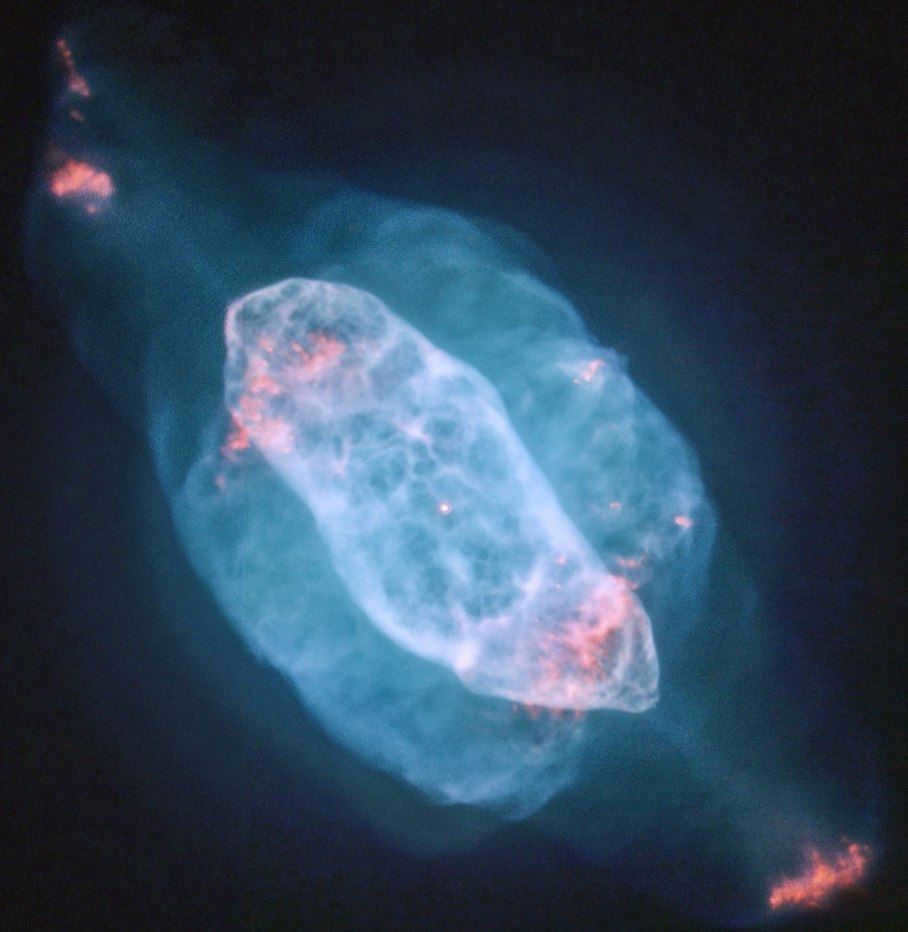
Image depicting NGC 7009, also known as the Saturn Nebula
An additional captivating structure frequently observed in close proximity to M73 is the Saturn Nebula (officially named NGC 7009). Its appearance closely resembles that of the planet Saturn, hence the aptly chosen name for this globular cluster. The Saturn Nebula is exceptionally luminous and noteworthy due to its abundance of kinematic and morphological subsystems.
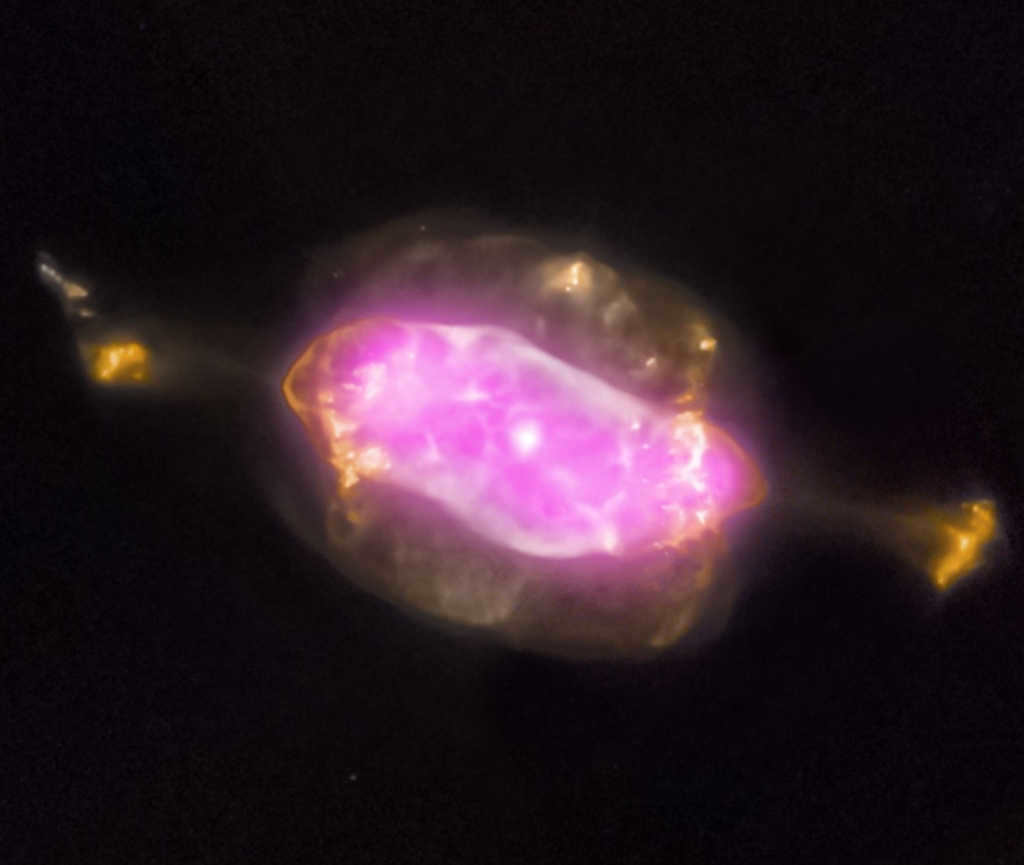
The picture shows NGC 7009 in the X-ray spectrum.
The origins of the Aquarius constellation
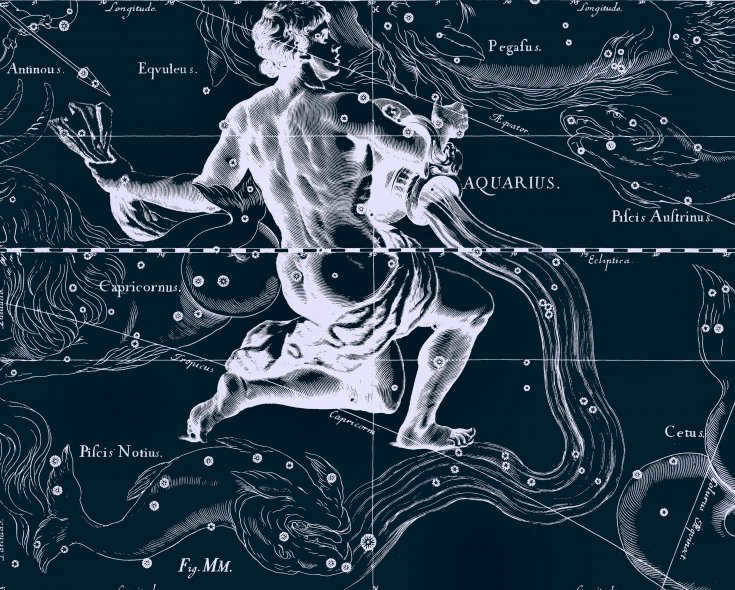

The image displays Aquarius, as depicted by Jan Hevelius in his collection of celestial configurations.
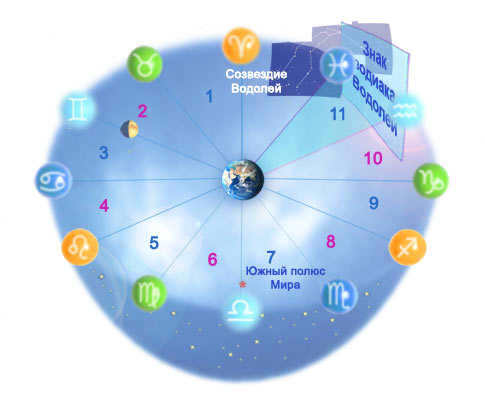
Figure 2 shows the symbol of the zodiac sign Aquarius along with the constellation Aquarius and their relative positions in a spherical projection. This representation is based on the ancient belief that the heavens consisted of multiple spheres surrounding the Earth.
In 2023, the most fortunate days for individuals born under the sign of Aquarius will be from February 16, 2023, 21:10 (when the Sun enters the constellation of Aquarius) until February 19, 2023, 01:34 MSK. During this period, Aquarius occupies a specific section of the zodiacal belt, as shown in the image above.
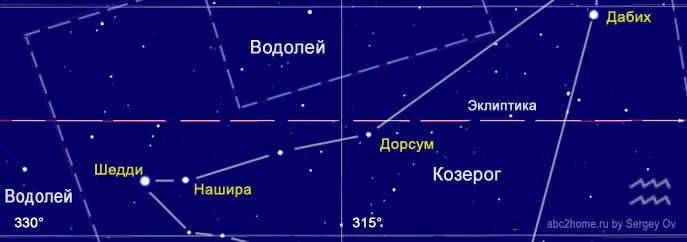
Figure 3. The Aquarius zodiac sign represents a portion of the zodiacal belt that corresponds to the Aquarius sign.
Within the Aquarius sign, there is a concentration of the brightest stars from the Capricorn constellation.
In ancient philosophy, the Aquarius sign is associated with the following characteristics:
– The Aquarius zodiac sign (Latin: Aquarius), named after the Aquarius constellation, is considered a masculine sign (according to the rules of alternation and the oldest legend of the constellation). Aquarius is also the second “airy” sign and is associated with the planet Saturn.
– Aquarius is the symbol of maturity and perfection of the Air element, therefore it is naturally attracted to the essential qualities of Air – moisture and warmth. These primary elements are embodied in individuals born under this sign, often displaying a prominent sanguine temperament as the dominant characteristic among others.
– In ancient times, Aquarius possessed additional characteristics and properties: it was located in the southern part of the celestial equator and was associated with the winter season. Aquarius also had connections with specific elements, such as lead (associated with Saturn) and the highly valued metal of gold. It was also linked to precious stones like sapphire and amethyst, as well as other transparent and blue stones.
Moreover, the sign of Aquarius had a significant trait – the influence of the Sun on earthly processes was minimal within this sign. Instead, the temperament of individuals born during the Sun’s presence in Aquarius was primarily shaped by Saturn and the interplay of other planets. (as believed by ancient philosophers).
The representation of ancient philosophers in the zodiacal sector of Aquarius suggests that the Sun, the Moon, and other planets have different levels of influence on earth processes:
☉ Sun. In Aquarius, which is a winter sign, the Sun’s influence on earthly life is relatively low (around 1/3 of a conditional point, where 1 point represents the power of influence at the moment of exaltation or fall). However, in Aquarius, the Sun’s influence starts to increase;
☽ Moon. The Moon’s influence on earthly processes is minimal in Aquarius, with a conditional “force” of 0 points;
♀ Venus in Aquarius enhances its influence, ranging from 1/3 to 2/3 points;
♃ Jupiter – In Aquarius, the influence of Jupiter continues to diminish (strength from 1 to 2/3 points);
☿ Mercury in Aquarius still ranks among the top three most influential planets (Strength from 1 1/3 to 1 point);
♂ Mars. In Aquarius – the influence of “Mars” is stronger than one, and its impact is noticeable (from 1 to 1 1/3 points);
♄ Saturn is at home in Aquarius, its influence is weaker than in Capricorn, but still significant, and it continues to exhibit its cold nature (from 3 to 2 2/3 points).
Since December 17, 2020, Saturn, the dominant celestial body during the winter of 2022-2023, has been positioned in Aquarius. It will continue to reside in Aquarius until March 7, 2023. This cosmic alignment, as stated by Ptolemy, sets the stage for chilly winters and a prevalence of Capricorns and Aquarians, often referred to as the “winter children.”
Aquarius: Understanding its Influence on Nature, Weather, and Plant Life
The Aquarius zodiac sign and individuals
“Individuals born under the Aquarius zodiac sign possess a remarkable flexibility in terms of their interests and emotions. They adapt swiftly to new environments, effortlessly connect with unfamiliar individuals, and boast an extensive network of acquaintances.”
In our era, an individual who is born under the Sun in the Aquarius zodiac sign is commonly referred to as an “Aquarius” and is attributed with the character traits traditionally associated with this sign. However, this may not necessarily be the case. The ancient Greeks believed that when the Sun is in this sign, it is “not yet in power”, and the ruling sign for the newborn is determined by other planets, often Saturn.
Ancient philosophers primarily believed that a person’s character is shaped by their life experiences, and the zodiac sign only determines the dominant temperament and mental strength (as per Ptolemy: “resistance to fate”) for those born under it:
The dominant temperament type for individuals born under the Aquarius sign is sanguine, with a high level of fortitude. However, reason and emotions are in harmony, which leads to many accomplishments in life, particularly in the fields of science and art. Aquarius is the most ambitious sign. In ancient Greek medicine, individuals “blessed” with the Aquarius sign were advised to take special care of their musculoskeletal system and avoid overloading their nervous system. A sedentary lifestyle is simply not recommended for Aquarius individuals.
The topic of Aquarius compatibility in relationships with other Aquarius individuals and those born under different zodiac signs, which is of interest to many, is discussed in a dedicated article: Compatibility Based on Zodiac Sign and Temperament. Different temperament types according to Hippocrates.
Aquarius Zodiac Sign and Its Impact on Russia
Historical Milestones in Russia Aligned with the Sun in Aquarius
February 7, 1238 – The Russian city of Vladimir was besieged and captured by the troops of Batyi;
January 22, 1440 – The birth of Ivan III Vasilyevich, who became the Grand Prince of Moscow;
February 19, 1651 – The Church Council of 1651 approved the mandatory “unanimity” rule, leading to the schism of the church;
February 7, 1693 – Anna I Ioannovna, who would later become the Russian Empress from 1730 to 1740, was born;
February 8, 1724 – St. Petersburg University and the St. Petersburg Academy of Sciences were established by decree of Peter the Great;
January 23, 1755 – Elizabeth I signed a decree to establish Moscow University;
February 13, 1769 – The birth of Ivan Andreyevich Krylov, a renowned Russian poet and fabulist;
February 8, 1834 – Dmitry Mendeleev, a prominent Russian chemist who discovered the periodic law of chemical elements, was born;
February 13, 1842 – Nicholas I signed a decree for the construction of the St. Petersburg-Moscow railroad;
January 29, 1860 – The birth of Anton Pavlovich Chekhov, a celebrated Russian writer and playwright;
February 9, 1887 – Vasily Ivanovich Chapayev, a hero of the Civil War, was born;
February 2, 1904 – Valery Chkalov, a Soviet test pilot and Hero of the Soviet Union, was born;
February 8, 1904 – The treacherous Japanese attack on Russian ships near Port Arthur marked the beginning of the Russo-Japanese War;
January 22, 1905 – “Bloody Sunday” occurred in St. Petersburg;
January 22, 1908 – The birth of Lev Landau, a Soviet physicist and academician;
February 1, 1931 – Boris Yeltsin, the first President of the Russian Federation, was born;
January 25, 1938 – The birth of Vladimir Vysotsky, a Soviet poet, bard, and actor;
February 2, 1943 – The defeat of Nazi troops at Stalingrad marked the end of the Battle of Stalingrad;
January 27, 1944 – The complete lifting of the Nazi blockade of Leningrad;
February 15, 1957 – Andrei Gromyko was appointed as the Minister of Foreign Affairs of the USSR.
Sergey Ov (Seosnews9)
Continuation of work on the article “Zodiac sign Aquarius” is in progress.
Abstracts: Aquarius zodiac sign and people: Aquarius zodiac sign, temperament. Compatibility issues. – Now being addressed in a separate article
* The constellation Aquarius
“The stars on the shoulders of Aquarius act like Saturn and Mercury, and the same applies to the stars on the left arm and cloak; the stars on the thighs act like Mercury and Saturn, respectively, to a greater and lesser extent; the stars on the jet of water act like Saturn and, to some extent, Jupiter.” (Fig.9)
Claudius Ptolemy – On the Influence of the Stars – “A Mathematical Treatise in Four Parts”
Currently, the constellation Aquarius is traversed by the Sun for a period of 24-25 days (sometimes 25 days due to a yearly quarter day shift): from February 16 to March 12. As a result of the precession of the Earth’s axis***, constellations gradually shift in relation to the vernal equinox point, causing the Sun to appear to move through them with a growing delay. The constellations, rotating counterclockwise, complete a full circle of the zodiac and return to their original positions every 25776 years.
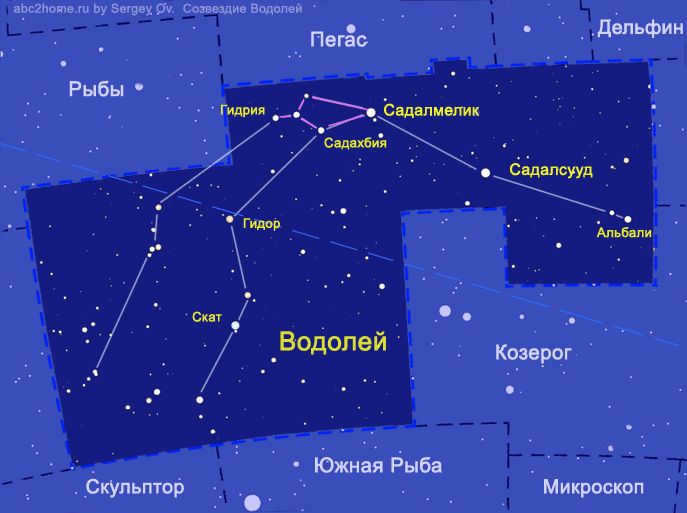
The diagram of the Aquarius constellation was created by Sergey Ov using stars.
Fig. 4 The Aquarius constellation (♒ Aquarius – Latin), the brightest stars.
The asterism known as the “Jug” is depicted with lilac lines. This is one of the possible ways to outline the Aquarius constellation. The best time to observe Aquarius is from the second half of August to early January. Aquarius reaches its highest point at midnight throughout August and most of September. The constellation is not known for its bright stars, with the brightest being β Aqr, Sadalsuud, which has an apparent magnitude of only 2.9.
The stars in Aquarius, which have their own names, are arranged in a row based on decreasing brightness (apparent stellar magnitude). They are as follows: Sadalsuud (β Aqr, 2.9); Sadalmelik (α Aqr, 2.95); Scat (δ Aqr, 3.27); Hydor (λ Aqr); Albali (ε Aqr); Sadahbia (γ Aqr); Hydria (η Aqr, 4.04).
Due to the constellation’s numerous stars of similar brightness, there are various visualization schemes for Aquarius. (You can explore these variations by moving your cursor over Fig. 4 or by clicking on the image for a larger picture.)
In the northernmost part of the constellation, five relatively bright stars form a shape resembling a jug, creating the asterism known as the “Jug.” However, the ancient Sumerians saw a duck instead of a jug in this position, which is associated with the ancient god Enki (Fig. 8). The Sumerians were the ones who associated the constellation with the element of “heavenly water.” Interestingly, the “Jug” asterism has a useful feature in modern times: its axial stars align with the celestial equator.
One of the most intriguing myths from Ancient Greece related to the Aquarius constellation dates back to the time of Homer. It tells the story of how Zeus was captivated by the joyful nature and beauty of the young Ganymede, son of the Trojan king. Giving in to his desires, Zeus transformed into an eagle and took Ganymede to Olympus. However, mortals cannot simply return from Olympus. Zeus had to negotiate with Ganymede’s father, promising him immortality for his son, and Ganymede himself had to find a permanent job. He found such a job on Olympus, becoming the cheerful cupbearer and water carrier of the gods. In those days, vessels with liquids were carried on the shoulder, which is depicted in Fig. 5: Ganymede tripped and spilled the water.
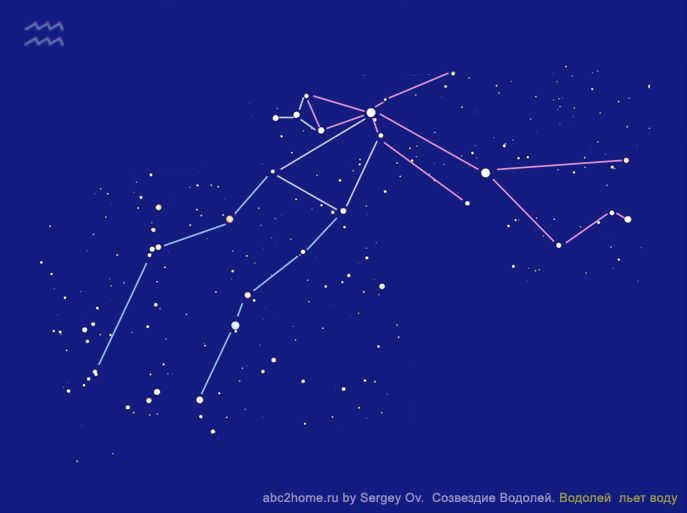
Here is a unique star chart of the Aquarius constellation called “Ganymede”.
Figure 5: An alternative way to represent the Aquarius constellation is by picturing a man (Ganymede) carrying a container of water on his shoulder, but in this case, he tripped, fell, and spilled the water. This can be used to tell children the story of the Tin Man (the concept is similar).
However, the ancient Egyptians, who associated the Aquarius constellation with the Nile, may have envisioned the constellation’s shape as shown in Figure 6. This led to the creation of the Aquarius zodiac sign ♒.
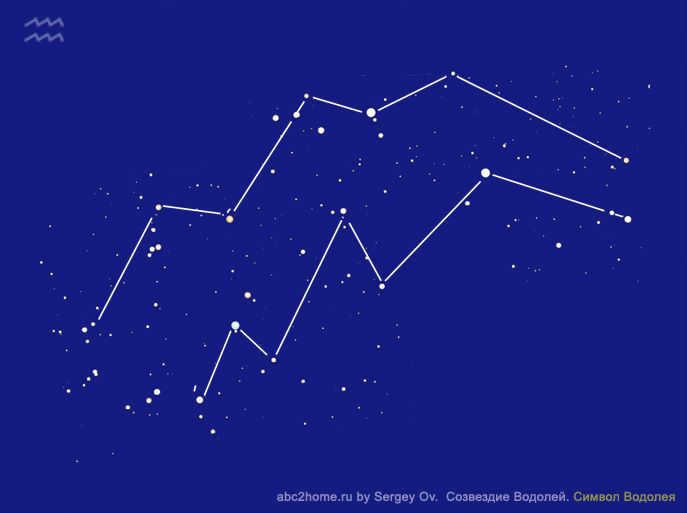
The Aquarius constellation is depicted in the image above. It is represented by the contour of the “Sign of Aquarius.” The diagram was created by Sergey Ov. Figure 6 shows the outline of the Aquarius constellation along with the symbol ♒ representing the “Sign of Aquarius.” This diagram was created by Sergey Ov and includes the positions of the stars.
In ancient times, astronomers from various civilizations observed the stars of the zodiacal belt in a unique way that differed from our perspective at average latitudes. In places like Babylon, Athens, and especially Alexandria, where the latitude was higher, the stars passed close to the zenith. The line of the ecliptic was nearly perpendicular to the horizon, and the stars appeared incredibly bright, as if one could almost touch them. On pleasant evenings in the southern regions, ancient intellectuals would gaze upon the constellations and allow their imagination to roam free.
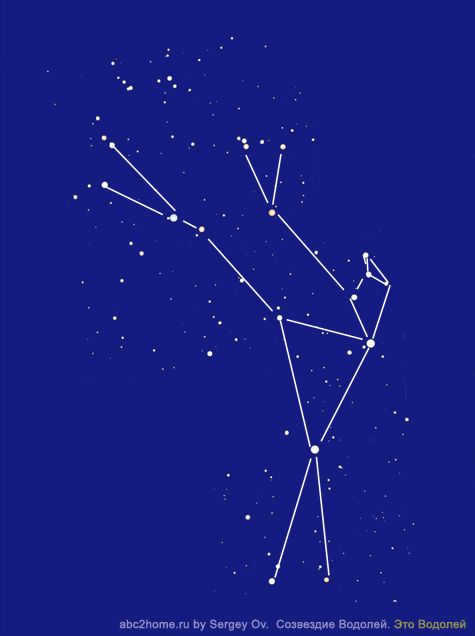
The diagram by Sergey Ov represents the Aquarius constellation in a contour drawing. It showcases the contours of the Aquarius constellation and illustrates one of its incarnations as an alien. This scheme provides a unique perspective on the Aquarius constellation. Figure 7 depicts the Aquarius constellation from above the East. Sergey Ov is the author of this intriguing diagram.
Sun in Aquarius. Dates from 2000 to 2023
| Year | The Sun enters Aquarius from Capricorn | The Sun moves from Aquarius to Pisces |
| 2023 | January 20, 2023 11:29 MSK | February 19, 2023 01:34 MSK |
| 2022 | January 20, 2022 05:39 MSK | February 18, 2022 19:43 MSK |
| 2021 | January 19, 2021 23:40 MSK | February 18, 2021 13:44 MSK |
| 2020 | January 20, 2020 17:54 MSK | February 19, 2020 07:57 MSK |
| 2019 | January 20, 2019 11:59 MSK | February 19, 2019 02:04 MSK |
| 2018 | January 20, 2018 06:09 MSK | February 18, 2018 20:18 MSK |
| 2017 | January 20, 2017 00:23 MSK | February 18, 2017 14:31 MSK |
| 2016 | January 20, 2016 18:27 MSK | February 19, 2016 08:34 MSK |
| 2015 | January 20, 2015 12:43 MSK | February 19, 2015 02:50 MSK |
| 2014 | January 20, 2014 07:50 MSK . | February 18, 2014 21:01 MSK |
| 2013 | January 20, 2013 01:52 MSK | February 18, 2013 16:04 MSK |
| 2012 | January 20, 2012 21:12 MSK | February 19, 2012 10:18 MSK |
| 2011 | January 20, 2011 13:18 MSK | February 19, 2011 03:24 MSK |
| 2011 | January 20, 2011 10:18 UTC | February 19, 2011 00:24 UTC |
| 2010 | January 20, 2010 04:23 UTC | February 18, 2010 18:33 UTC |
| 2009 | January 19, 2009 22:37 UTC | February 18, 2009 12:47 UTC |
| 2008 | January 20, 2008 16:43 UTC | February 19, 2008 06:53 UTC |
| 2007 | January 20, 2007 11:00 UTC | February 19, 2007 01:10 UTC |
| 2006 | January 20, 2006 05:14 UTC | February 18, 2006 19:24 UTC |
| 2005 | January 19, 2005 23:20 UTC | February 18, 2005 13:30 UTC |
| 2004 | January 20, 2004 17:40 UTC | February 19, 2004 07:50 UTC |
| 2003 | January 20, 2003 11:52 UTC | February 19, 2003 02:00 UTC |
| 2002 | January 20, 2002 06:02 UTC | February 18, 2002 20:13 UTC |
| 2001 | January 20, 2001 00:16 UTC | February 18, 2001 14:27 UTC |
| 2000 | January 20, 2000 18:23 UTC | February 19, 2000 08:33 UTC |
** There are several common definitions of the sanguine temperament type and the behavioral characteristics of those who possess it. According to the Bolshaya Sovetskaya Encyclopedia, the sanguine temperament is one of the four types of temperament identified by the ancient Greek physician Hippocrates. It is characterized by vivacity, rapid excitability, and easy changeability of emotions. Another definition from the Glossary of Psychological Terms describes sanguine as a temperament in the HIPPOCRAT classification, with individuals characterized as lively, agile, quick to respond to surrounding events, and relatively easy to experience failure and trouble. The Dictionary of Practical Psychologist further defines sanguine as a subject possessing one of the four basic types of temperament, marked by high mental activity, vigor, efficiency, and quickness in movements and facial expressions. They strive for a frequent change of impressions, easily respond to external events, and are sociable. These definitions can be summarized as follows: Sanguine individuals are lively, agile, and quick to respond to their surroundings. They easily adapt to new environments, have a wide circle of acquaintances, and can work for long periods without getting tired. They are particularly active in the sphere of contacts and communication. Sanguine individuals do not strive for creative transformation of the surrounding world and depend heavily on the psychological environment and behavioral stereotypes of their surroundings.
*** The precession of the Earth’s axis is another slow rotation of the Earth caused by the gravitational forces of the Sun and Moon, resulting in a gradual change in the direction of the Earth’s daily rotation axis.
**** An asterism is an easily distinguishable group of stars that has a well-established independent name.





